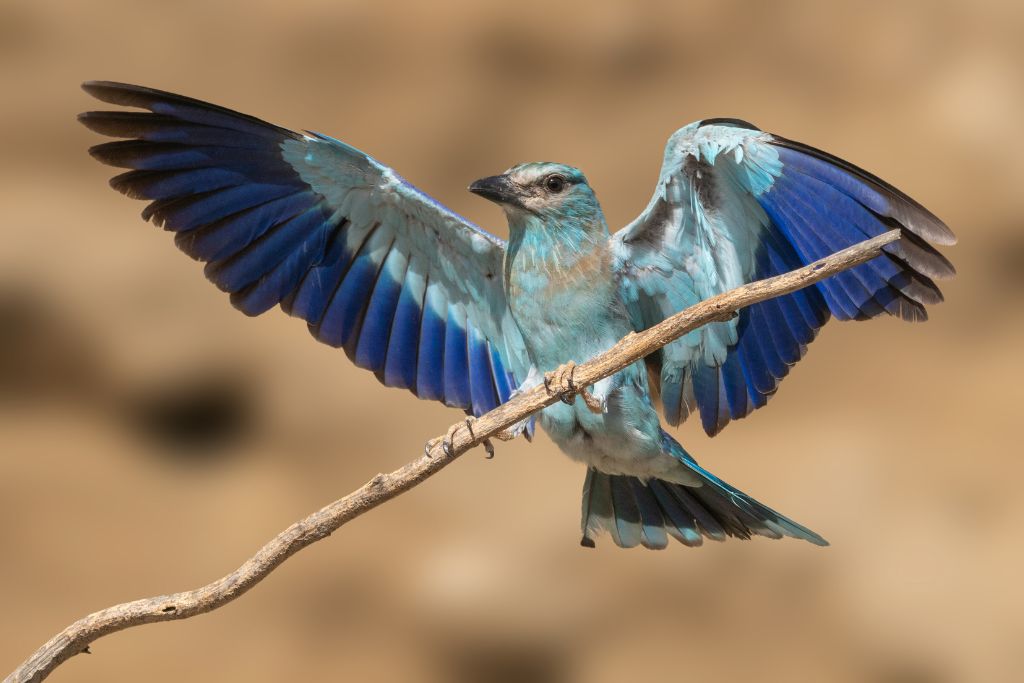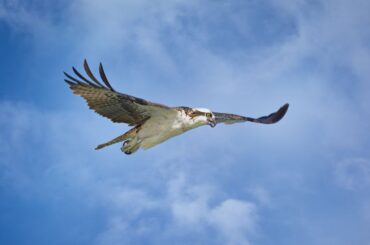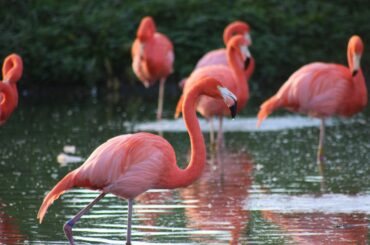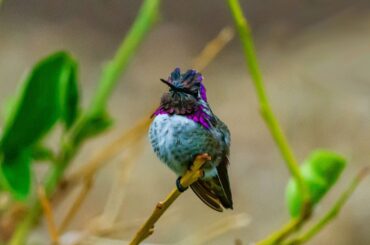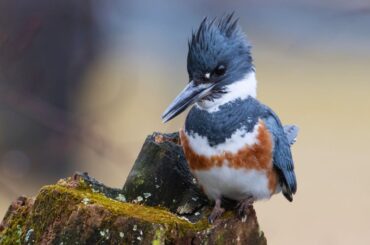Have you ever admired the beautiful plumage of birds flying across Florida skies, their melodies carried by the warm breeze? The Sunshine State has a fantastic variety of birds for birdwatchers and wildlife lovers.
Florida, with its diverse ecosystems and favorable climate, is a haven for over 500 species of birds. Its unique location as a migratory crossroads attracts a wide variety. You’ll see many birds whether touring the Everglades, Gulf Coast beaches, or parks.
One fascinating fact about Florida is its significant role as a nesting site for several iconic bird species. It is a sight to behold when these long-legged wonders gather in large flocks, casting a picturesque reflection on the tranquil waters they call home.
Whether you’re a seasoned birdwatcher or a nature lover, Florida’s many bird species will amaze you and deepen your love of nature.
What do Common Birds look like in Florida?
Common Florida birds range from small to moderate-sized, fitting their different environments. From the blue jay’s playful antics to the northern cardinal’s strong presence, these birds never fail to enchant. As for their color palette, one is greeted with a kaleidoscope of hues that rival the most breathtaking sunsets.
When it comes to their characteristics, common birds in Florida exhibit a fascinating assortment of behaviors and traits. Their enchanting songs turn even a simple walk into a natural symphony. These birds can be found throughout the state, with some favoring coastal habitats and others lush forests or marshes.
1. American Robin
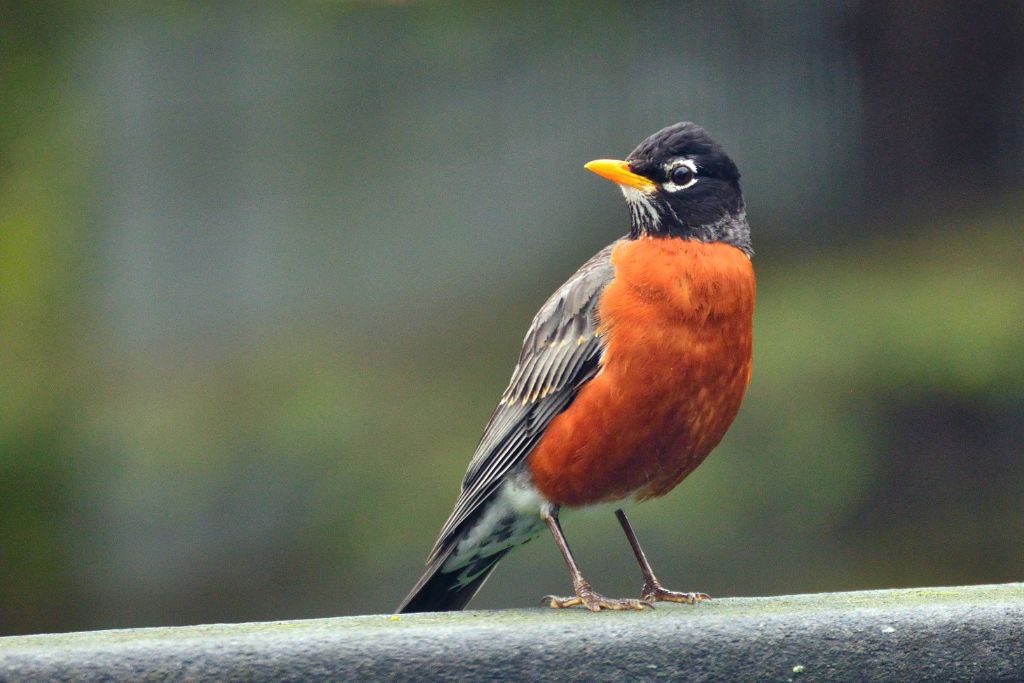
- Kingdom: Animalia
- Phylum: Chordata
- Class: Aves
- Order: Passeriformes
- Genus: Turdus
- Species: T. migratorius
The American robin (Turdus migratorius) stands out among birds for its erect posture and beautiful voice. Adult robins measure about 9 to 11 inches long, with a wingspan ranging from 12 to 16 inches. They have a keen eye for spotting earthworms and insects, which form most of their diet.
The vision of American robins has adapted to their environment. Their eyes have a specialized protein that allows them to perceive colors in the ultraviolet range. This adaptation helps them locate ripe fruits, such as berries, which appear brighter under ultraviolet light.
Their singing can often be heard at dawn and dusk. This beautiful melody is a common feature in North American neighborhoods and has even inspired songs and poetry throughout history.
The average wild American robin lives 2 to 6 years, although some survive up to 13 years. Predators, diseases, and seasonal resource availability all have a role in determining how long they will live. Despite these limitations, the American robin continues to brighten our landscapes.
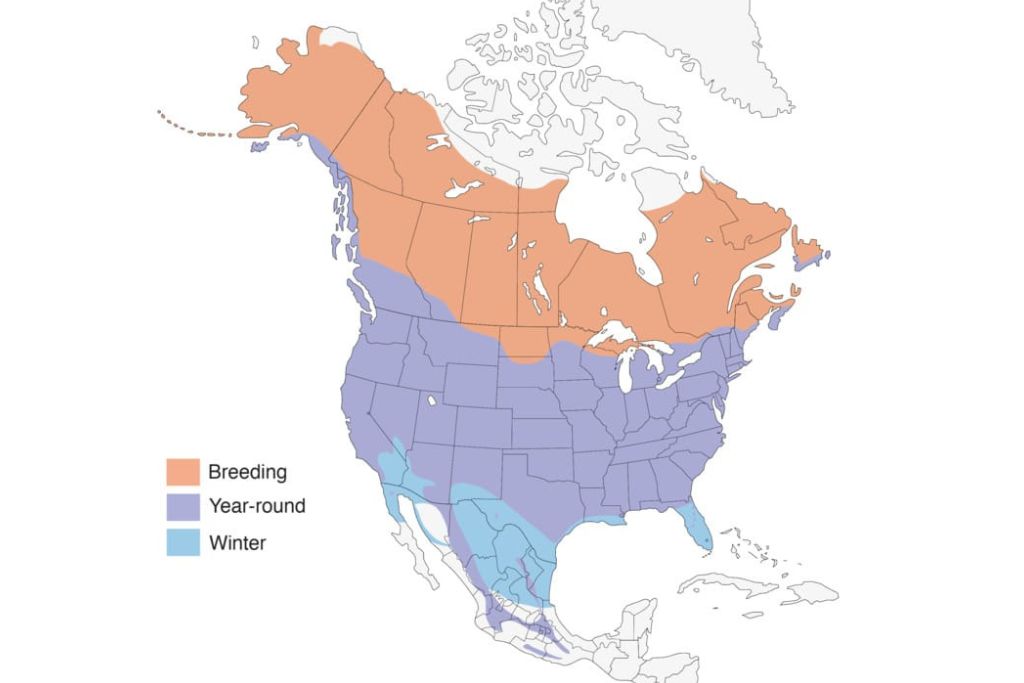
2. American Goldfinch
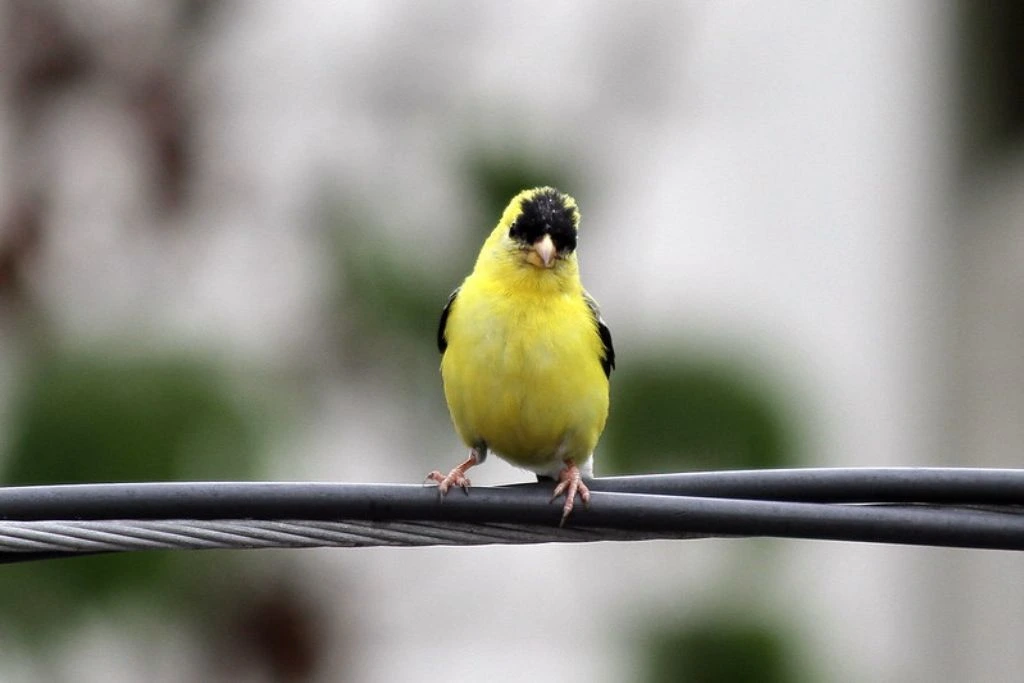
- Kingdom: Animalia
- Phylum: Chordata
- Class: Aves
- Order: Passeriformes
- Genus: Spinus
- Species: S. tristis
The lively American goldfinch (Spinus tristis) is widespread across North America, including Florida.
During the breeding season, male American goldfinches have dazzling yellow plumage with black wings and tails. Females have olive-brown feathers that help them blend in. These finches have a small, conical beak that is ideally suited for feeding on seeds, which form the bulk of their diet.
Their beak is specifically designed to extract seeds from plants. They can access the tightly secured seeds within thistle and sunflower heads using their slender beaks. This adaptability allows them to thrive in locations rich in seed-producing plants, making Florida’s various ecosystems perfect.
They are the only finch species in North America that undergoes a complete molt. Both males and females lose and replace their feathers twice a year, resulting in drab winter plumage. The lovely, tinkling sound of these finches delights nature lovers.
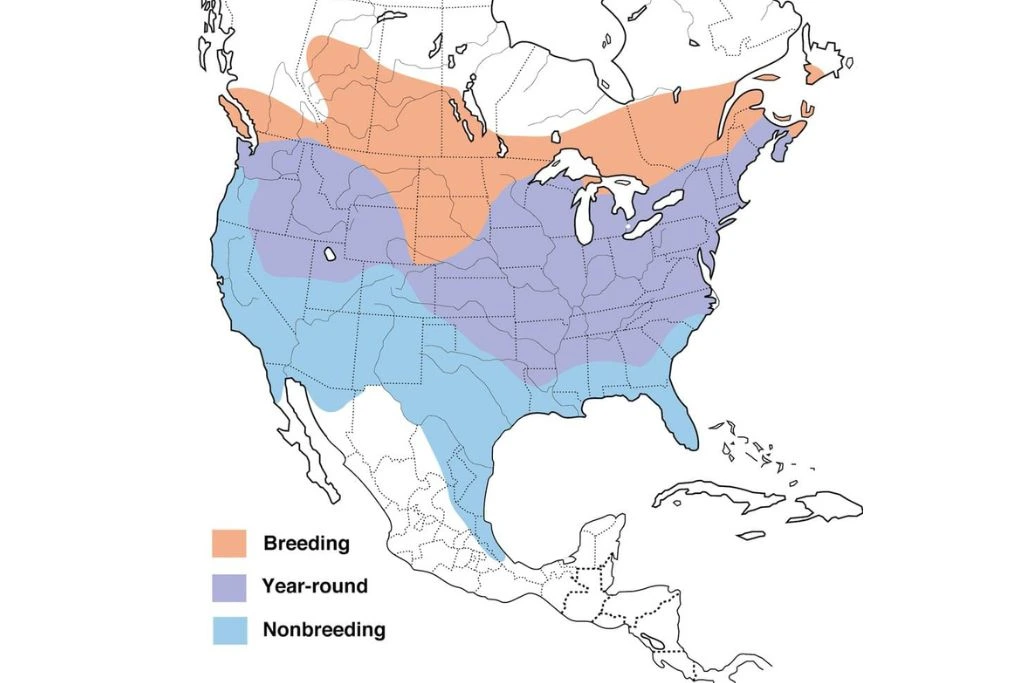
3. American Avocet
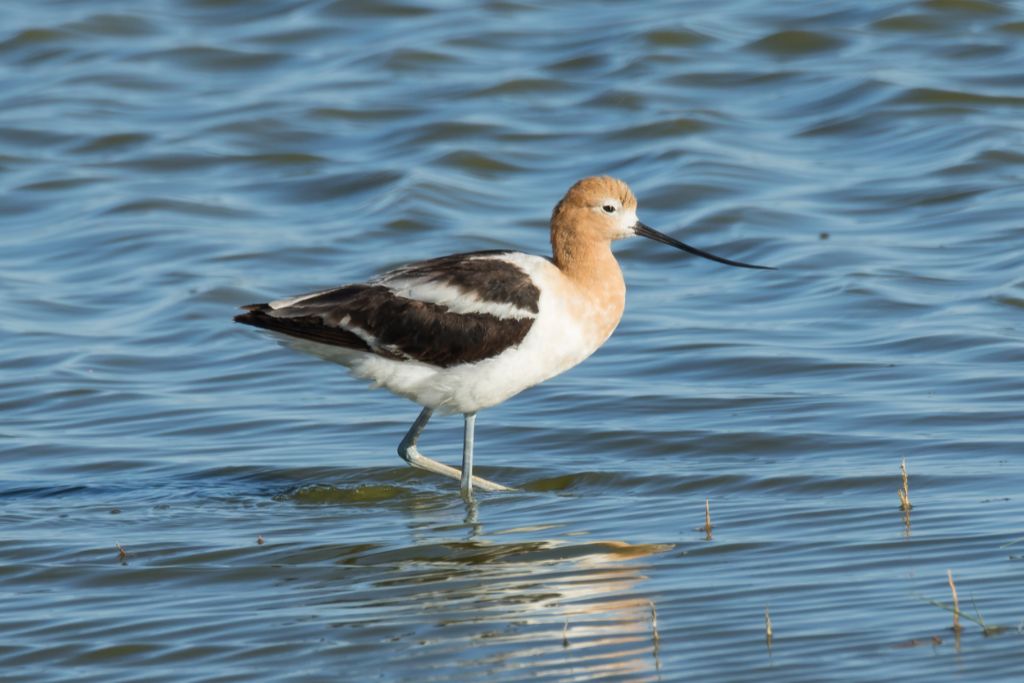
- Kingdom: Animalia
- Phylum: Chordata
- Class: Aves
- Order: Passeriformes
- Genus: Recurvirostra
- Species: R. americana
The American avocet (Recurvirostra americana) stands out with its slender body, long legs, and distinct upward-curving bill. The bird’s bill is excellent for sweeping side to side in shallow water to catch small invertebrates and aquatic insects.
Beautiful black and white plumage covers the heads, wings, and necks of these birds during the breeding season. Their legs change from gray to a beautiful cinnamon hue during this time.
They possess partially webbed feet, enabling them to walk on soft mud and easily navigate through shallow waters. Coastal mudflats, salt pans, marshes, and shallow freshwater lakes are just some of the places you can spot one of these birds. During migration, they find refuge in Florida’s wetlands due to the abundant food and nesting grounds.
American avocets hunt prey by sweeping their bills in the water. They rush in a line during courting, fluttering their wings and screaming. If they survive their habitat, American Avocets can live up to 15 years.
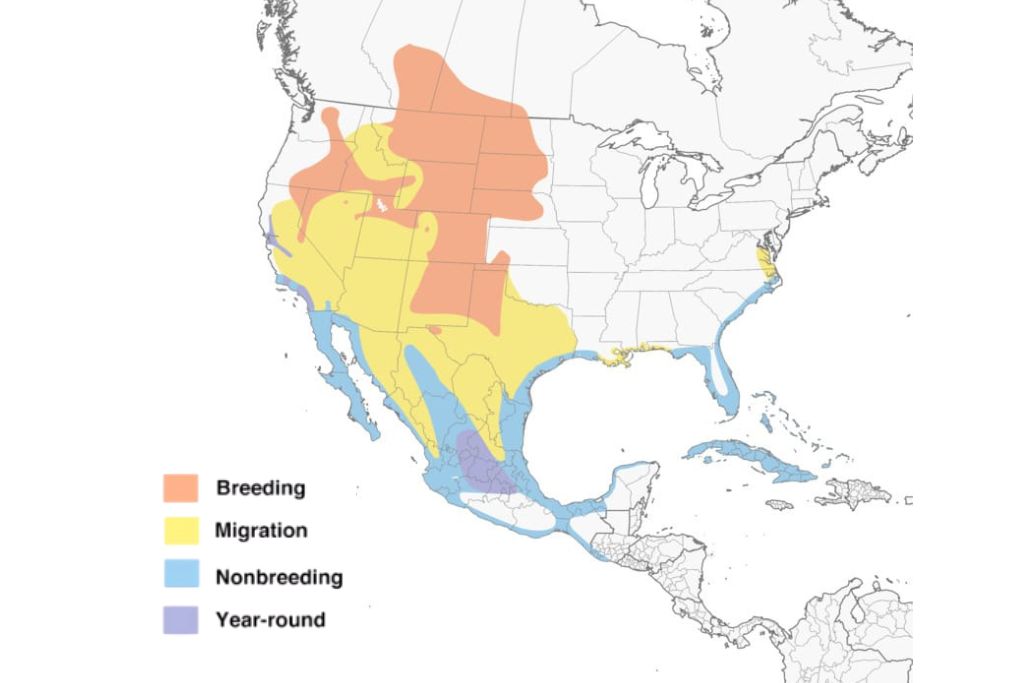
4. American Crow
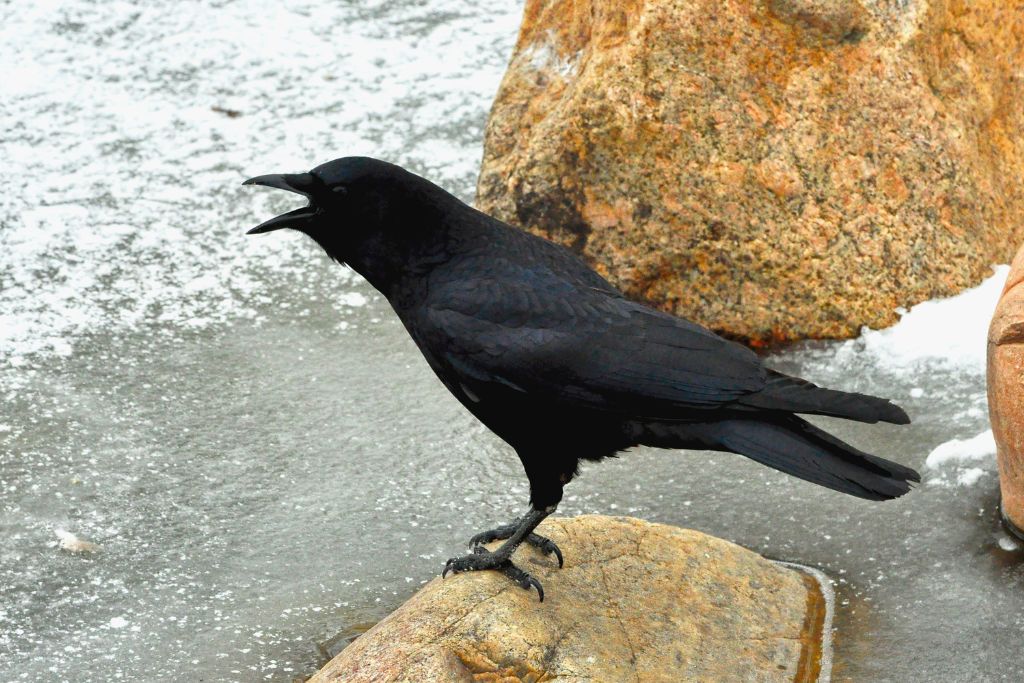
- Kingdom: Animalia
- Phylum: Chordata
- Class: Aves
- Order: Passeriformes
- Genus: Corvus
- Species: C. brachyrhynchos
The American crow (Corvus brachyrhynchos) is famous for its jet-black feathers, sturdy physique, and cawing calls. They are approximately 17 to 21 inches long, with a wingspan ranging from 33 to 39 inches. Their beaks are strong and slightly curved, allowing them to forage for various food efficiently.
They thrive in forests, fields, cities, and the coast. These resourceful birds are known to scavenge for food, feeding on insects, small mammals, fruits, seeds, and carrion. Their adaptable nature enables them to exploit various food sources, contributing to their widespread distribution.
American crows have a wide range of calls and noises for social communication. These intelligent birds also exhibit remarkable problem-solving skills and have been observed using tools in the wild. During the non-breeding season, they gather in large communal roosts to interact and defend against predators.
The average life expectancy of an American crow varies around 7 to 8 years in the wild. Some individuals have been known to live for up to 14 years. In Florida, American crows are found in woodlands, residential neighborhoods, parks, and even near agricultural fields.
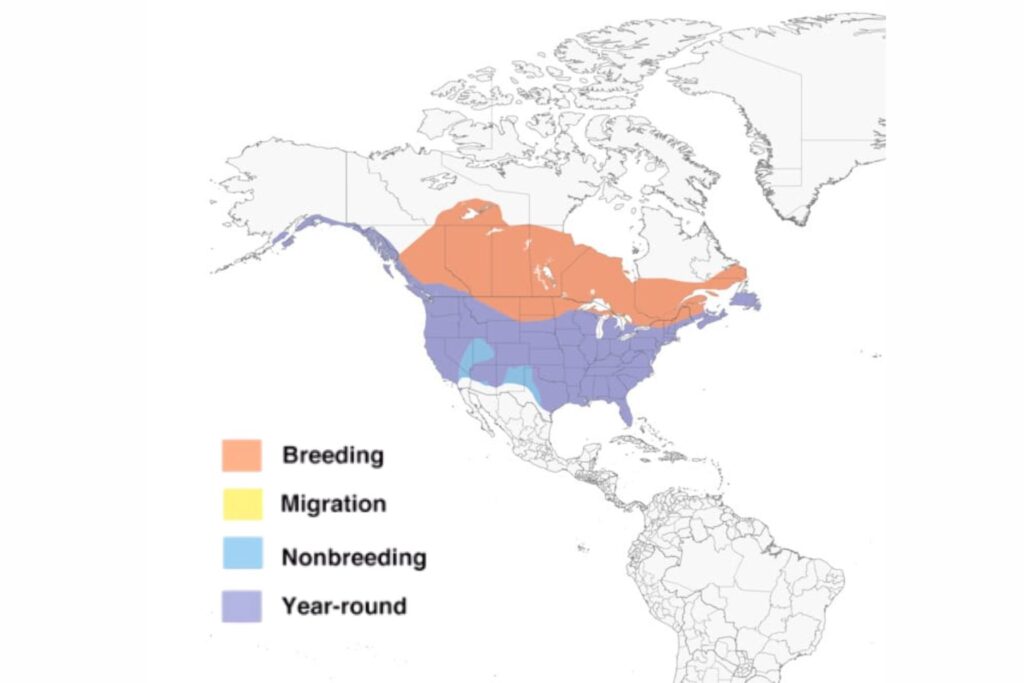
5. Baltimore Oriole
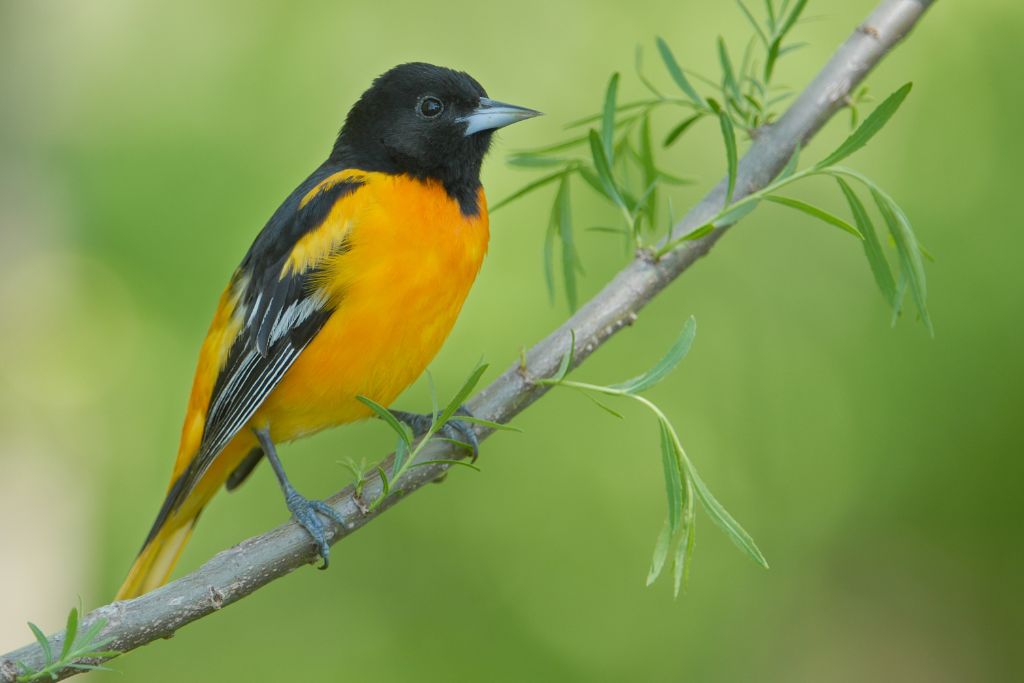
- Kingdom: Animalia
- Phylum: Chordata
- Class: Aves
- Order: Passeriformes
- Genus: Icterus
- Species: I. galbula
The Baltimore oriole (Icterus galbula) is a stunning songbird native to North America. With its distinctive black and orange coloration, the Baltimore Oriole is easily recognizable among its feathered counterparts.
Their sharp, pointed beaks allow them to efficiently forage for nectar, fruit, and insects. Their powerful legs and feet make hopping from branch to branch easy. The gape reflex, a unique feature of the Baltimore oriole, allows the bird to open its beak further when feeding its young.
They’re found in Florida’s woodlands, suburbs, marshes, and swamps. These birds prefer areas with abundant trees to construct their intricate nests.
The male orioles are responsible for serenading us with their enchanting songs. Their melodic tunes fill the air, often resembling flute-like sounds. As for their life expectancy, Baltimore Orioles typically live up to 8 to 10 years in the wild.
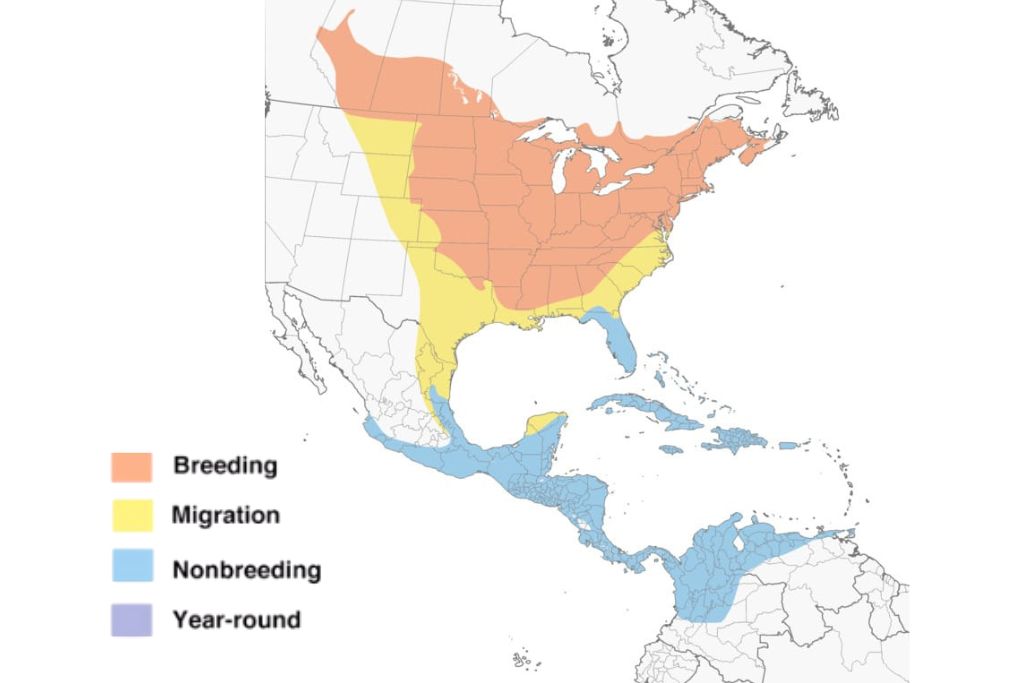
6. Brown-Headed Cowbird
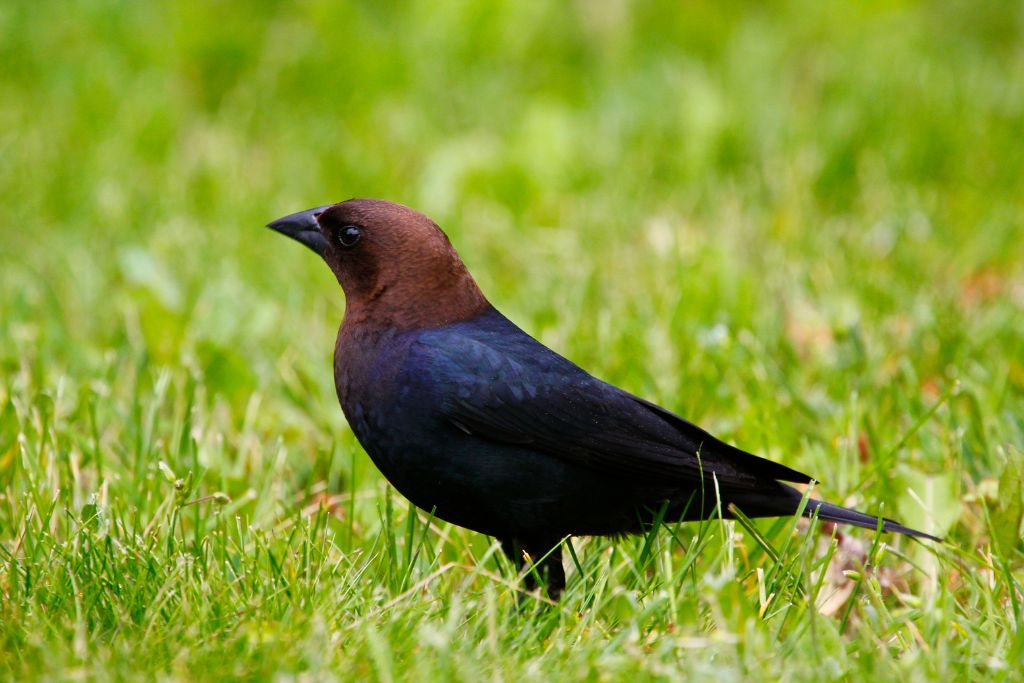
- Kingdom: Animalia
- Phylum: Chordata
- Class: Aves
- Order: Passeriformes
- Genus: Molothrus
- Species: M. ater
The brown-headed cowbird (Molothrus ater) is widespread throughout North America, including Florida. They have glossy black plumage and a brown head. Males are sleeker and more striking than females.
These birds have a sturdy build, measuring about 7 to 8 inches long and weighing around 1.5 ounces. They also have short, thick bills that are adapted for foraging on the ground. In the wild, the brown-headed cowbird lives 2 to 3 years.
Brood parasites like the brown-headed cowbird don’t establish nests or nurture their young. Instead, they rely on other bird species to raise their offspring. This adaptation permits the cowbird to focus on breeding and reproducing by laying its eggs in warbler, finch, and sparrow nests.
They “egg-dump” by recognizing and removing their eggs from other birds’ nests. This behavior helps minimize the chances of host birds discovering and destroying their eggs.
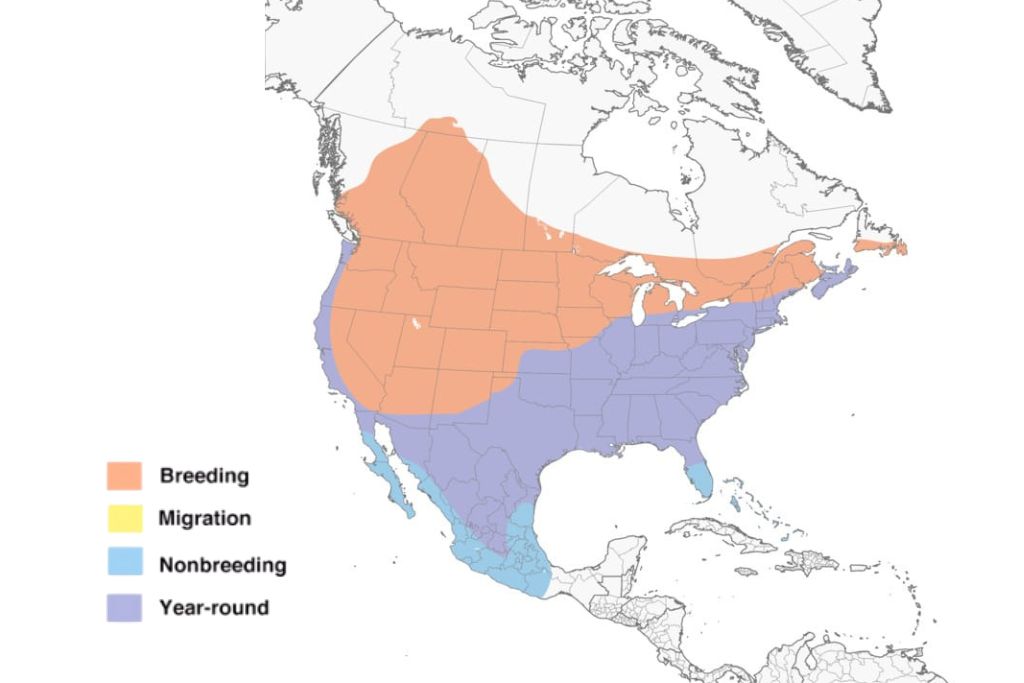
7. Blue Jay
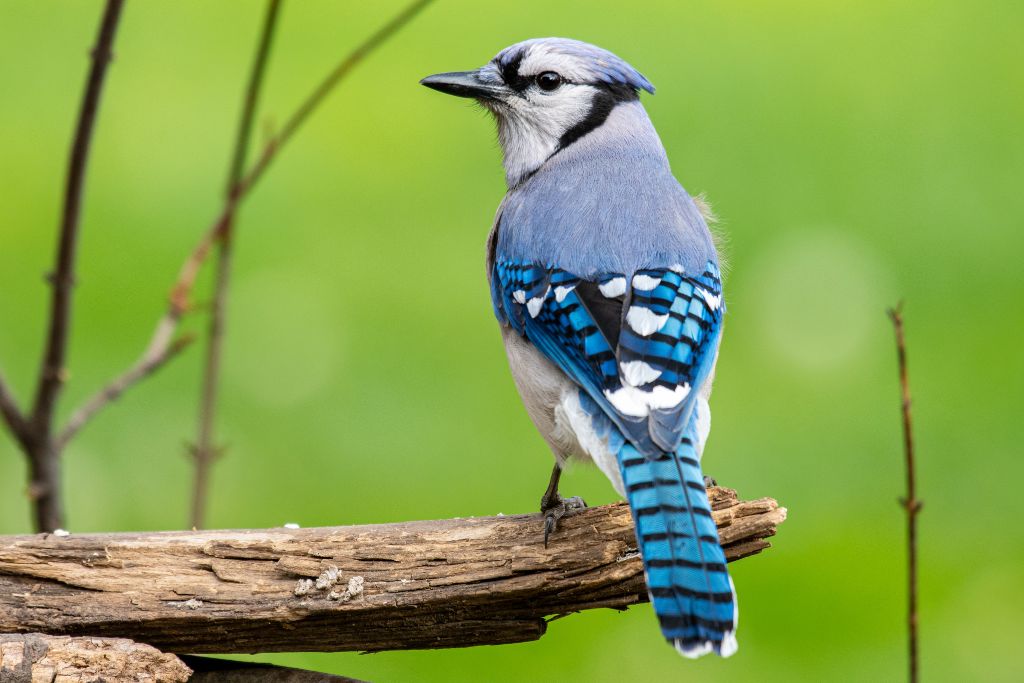
- Kingdom: Animalia
- Phylum: Chordata
- Class: Aves
- Order: Passeriformes
- Genus: Cyanocitta
- Species: C. cristata
Blue jays (Cyanocitta cristata) are easily identified by their blue plumage, white underparts, and black wings and tail. Their crests, perched atop their heads, add to their unique charm. These birds have solid bills for cracking open nuts and seeds, and their wings are perfectly designed for swift flight.
They are opportunistic scavengers that eat nuts, seeds, insects, and fruits. They can spot threats quickly and warn other birds with powerful calls.
They live in urban and rural forests, woodlands, parks, and suburban gardens. These birds are commonly seen in Florida, particularly in wooded regions with ample trees for nesting and foraging. They nest in open regions with trees and shrubs because the dense foliage protects them from predators.
The blue jay’s intelligence and ability to mimic other birds and humans are fascinating. They are known to imitate the calls of hawks, which can confuse potential predators. They also help spread seeds by hiding acorns and other nuts for future consumption.
Some blue jays have lived up to 17 years in the wild, but the average lifespan is 7.
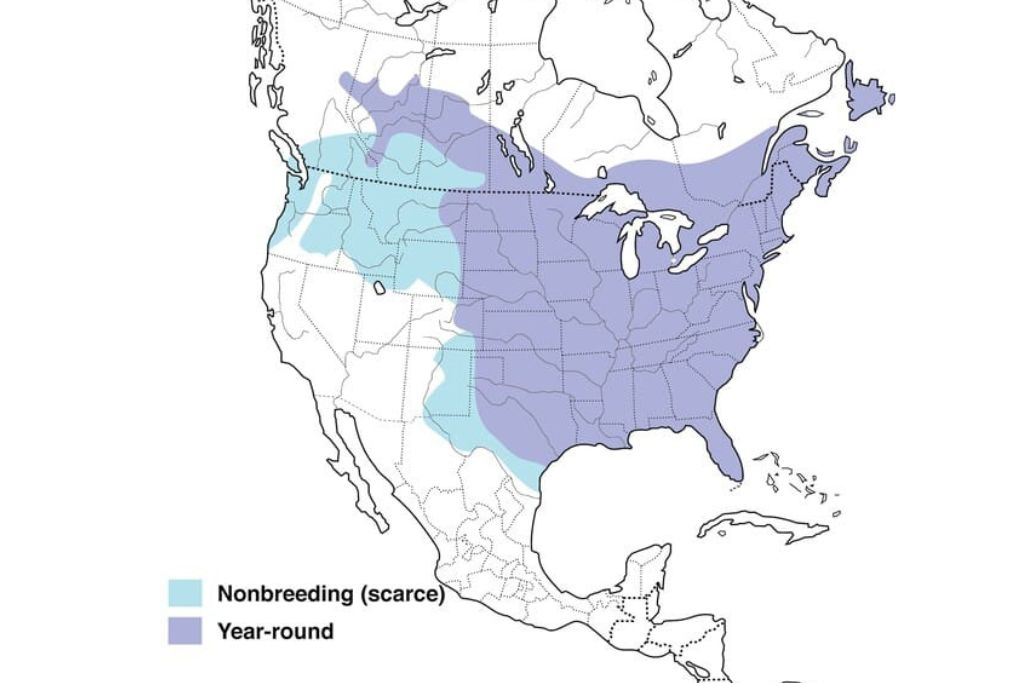
8. Boat-Tailed Grackle
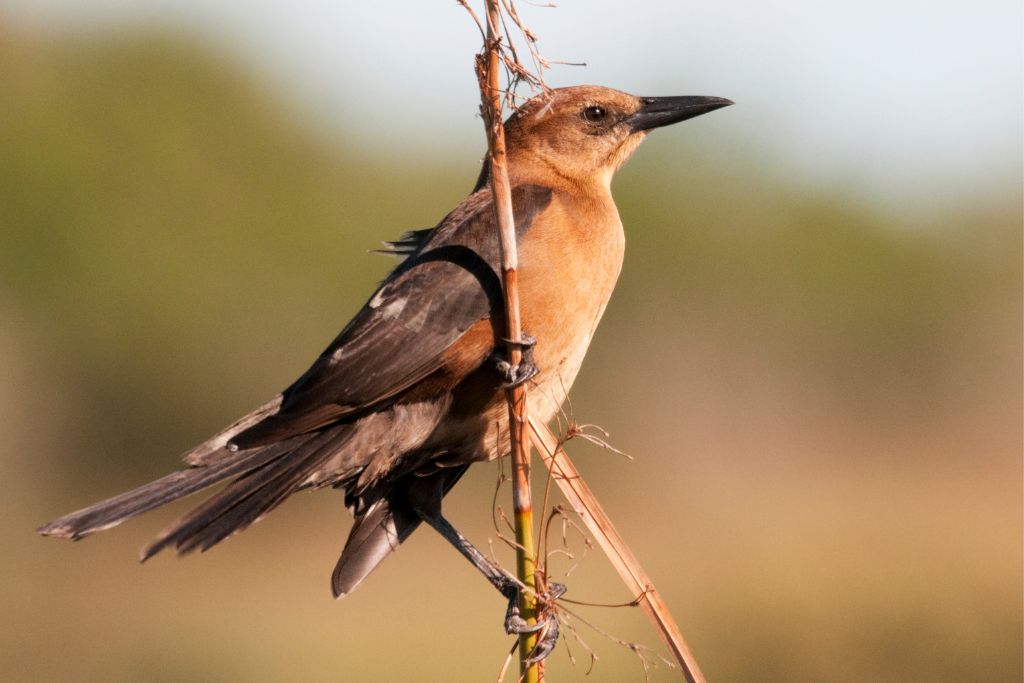
- Kingdom: Animalia
- Phylum: Chordata
- Class: Aves
- Order: Passeriformes
- Genus: Quiscalus
- Species: Q. major
Boat-tailed grackles (Quiscalus major) are stunning birds with fascinating behavior. When exposed to sunlight, the males’ glossy black plumage shimmers blue and purple. Females have brown feathers that hide them and their nests.
They search for insects, small crustaceans, and seeds with sharp, pointed beaks. They have excellent vision and can forage successfully in various environments, including seashores and cities. Their webbed feet and strong legs help them wade across shallow waters, where they find their favorite meals.
The boat-tailed grackle’s habitat preferences are as diverse as its diet. They are commonly found in marshes, wetlands, and coastal regions, particularly in the Sunshine State of Florida. These friendly birds gather on trees, power lines, and rooftops, calling out in large groups.
The average lifespan of a boat-tailed grackle in the wild is between 6 and 8 years. Due to their adaptability and ability to avoid predators, some have survived for over 10 years.
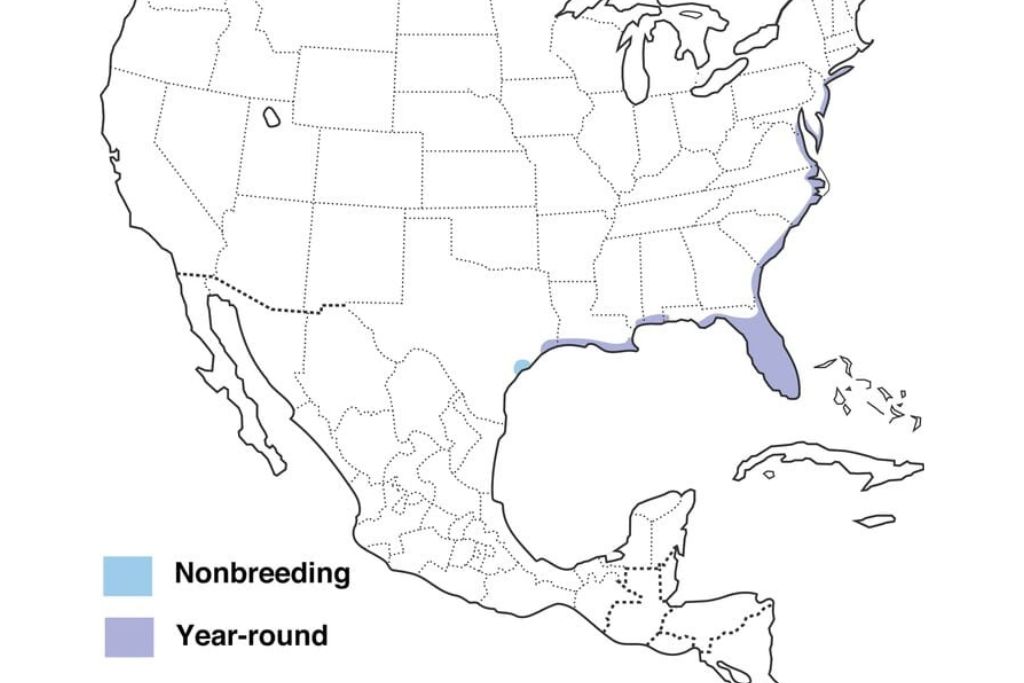
9. Carolina Wren
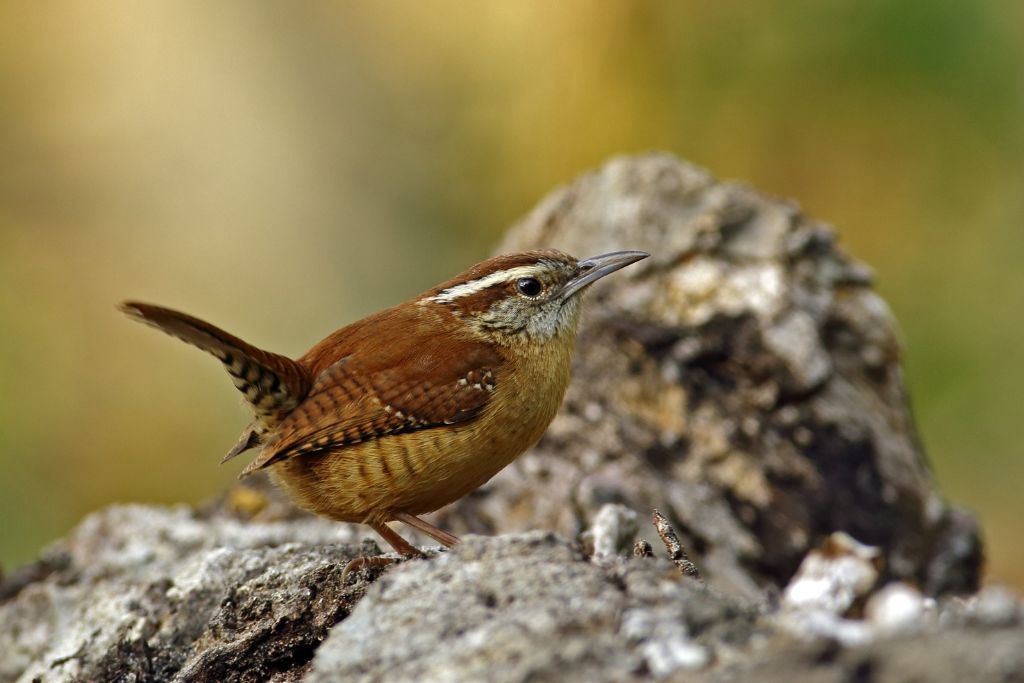
- Kingdom: Animalia
- Phylum: Chordata
- Class: Aves
- Order: Passeriformes
- Genus: Thryothorus
- Species: T. ludovicianus
Carolina wrens (Thryothorus ludovicianus) are small yet mighty birds native to the southeastern parts of the United States. Their large bodies, reddish-brown plumage, and characteristic white eyebrows make them irresistible. They have short wings and a slightly curved bill that aids them in foraging for food efficiently.
Because of their powerful legs and agility, they can quickly move through dense vegetation. They hunt insects, spiders, and other small invertebrates using their keen claws on trees and vertical surfaces. They’re found in parks, gardens, and suburban and urban regions with lots of greenery in Florida.
These birds often build what are called “dummy nests.” These decoy nests are built near the nest and serve as a defensive tactic to confuse predators. If a predator finds the dummy nest, the wren parents quickly move their eggs to a safer spot to save their kids.
They typically have a life expectancy of around 6 years in the wild. Protecting and preserving these beautiful birds is crucial to ensuring their continued existence.
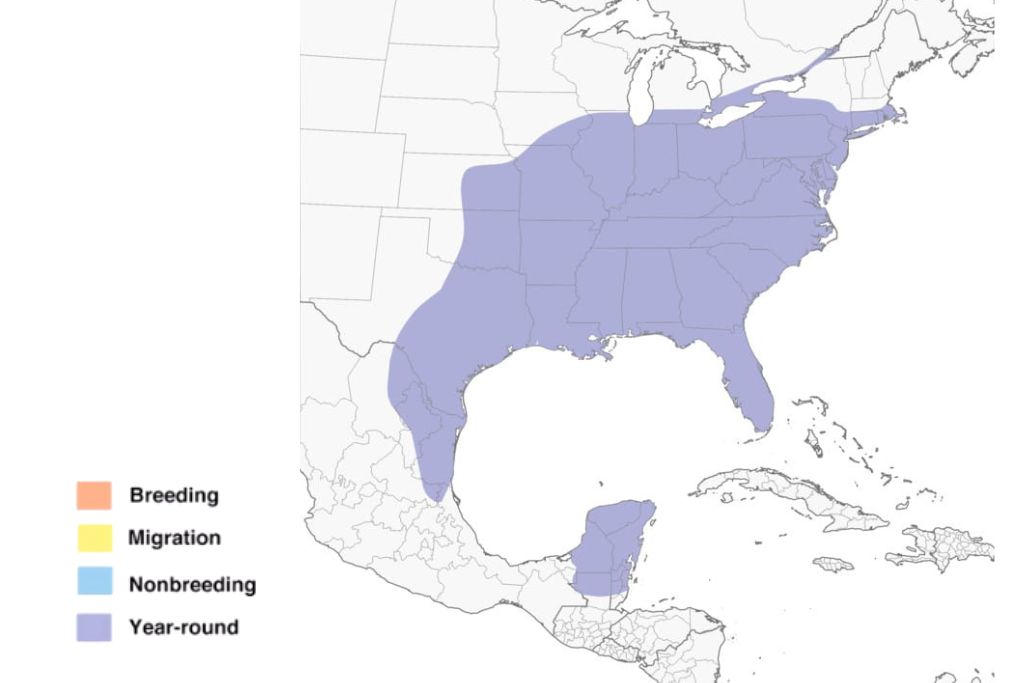
10. Common Grackle
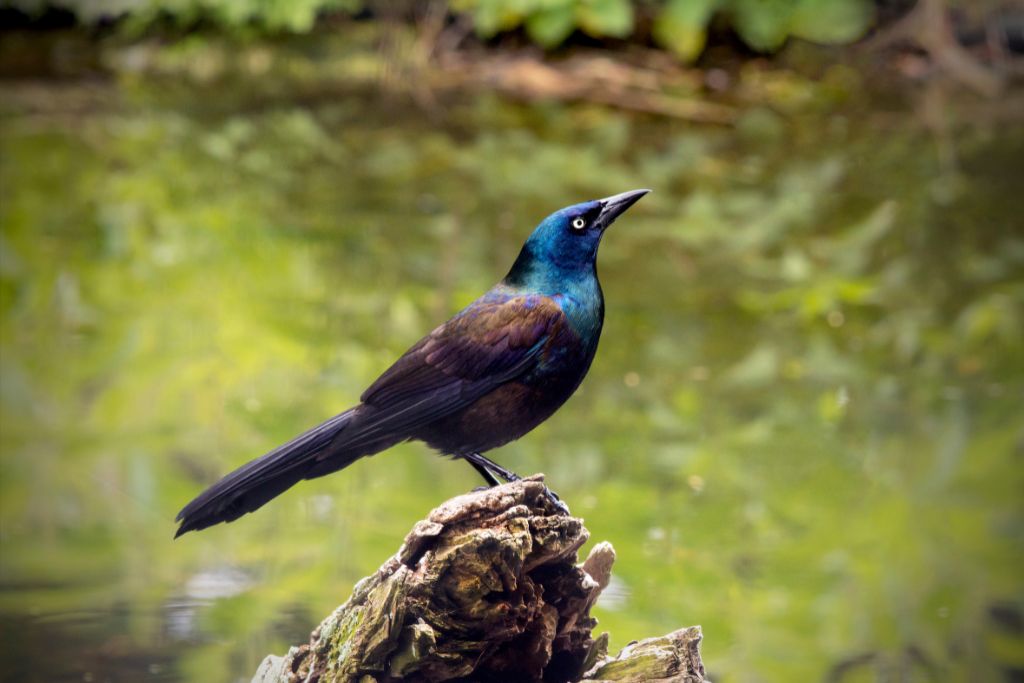
- Kingdom: Animalia
- Phylum: Chordata
- Class: Aves
- Order: Passeriformes
- Genus: Quiscalus
- Species: Q. quiscula
The common grackle (Quiscalus quiscula) is a medium-sized bird measuring 12 to 13 inches long. It has a sleek black plumage with an iridescent sheen that shines with purple, green, and blue hues when sunlight hits it. With its long tail and yellow eyes, this plumage gives the common grackle a striking and unique appearance.
The male and female grackles look similar, but the male is slightly larger and displays a longer tail. They are highly adaptable birds, known for their ability to thrive in various habitats. They can be found in urban areas, farmlands, woodlands, and wetlands.
One interesting fact about common grackles is their vocal repertoire. They are known for their diverse and noisy calls ranging from high-pitched squeaks to low, guttural sounds. These vocalizations serve various purposes, including communication within the colony, warning calls, and courtship displays.
The life expectancy of common grackles is typically around 3 to 4 years in the wild. Their survival rates are influenced by predation, disease, and habitat availability. Common grackles are found in many environments in Florida, including urban parks, suburban communities, and agricultural areas.
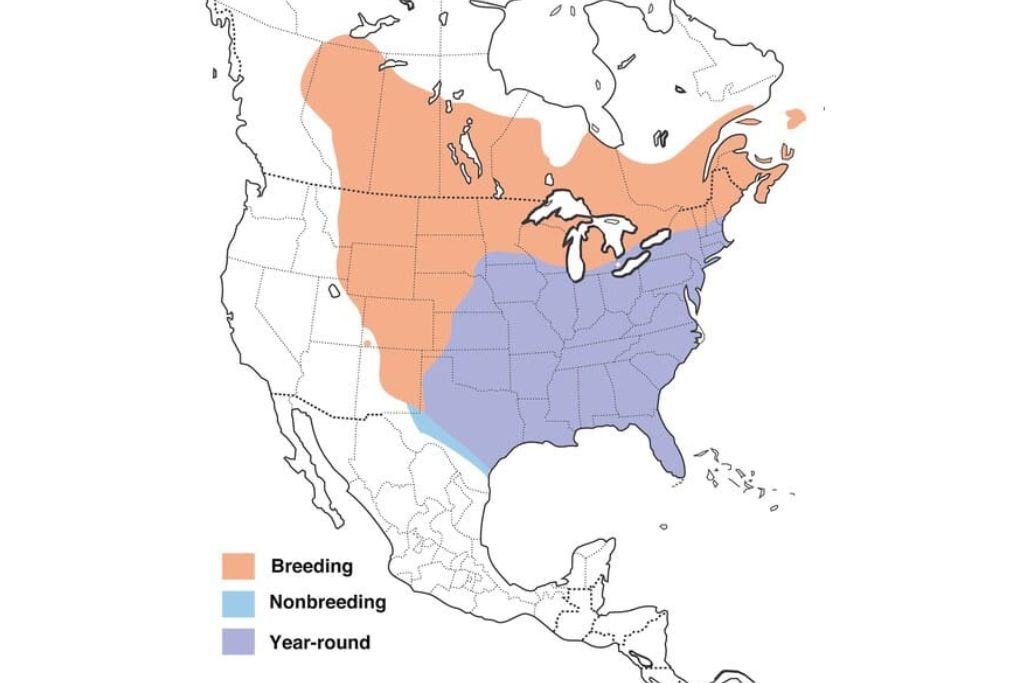
11. Chipping Sparrow
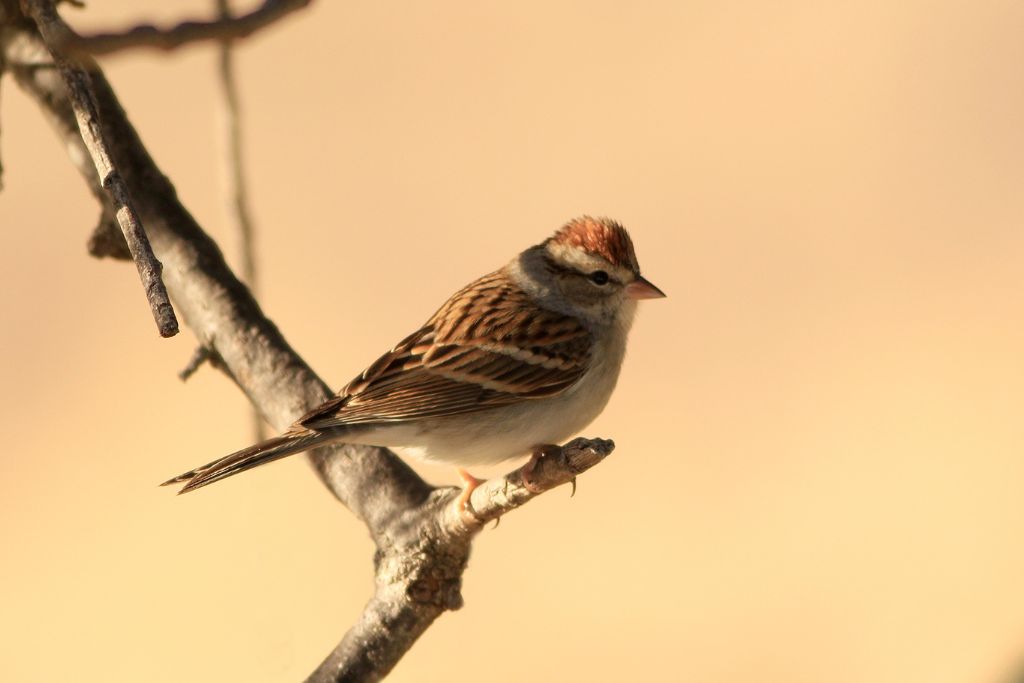
- Kingdom: Animalia
- Phylum: Chordata
- Class: Aves
- Order: Passeriformes
- Genus: Spizella
- Species: S. Passerina
The chipping sparrow (Spizella passerina) is a tiny passerine bird with a reddish-brown hat and crisp white eyebrows.
Its slender beak is perfectly designed for extracting seeds from a variety of sources, including grasses, flowers, and trees. This adaptability allows the chipping sparrow to sustain itself on various food sources throughout the year. It blends in with its environment and protects itself from predators with its feathers.
When it comes to habitat, the chipping sparrow prefers open woodlands, parks, gardens, and forest edges. In Florida, these charming birds are found in mixed forests and open spaces in the north and center.
Interestingly, chipping sparrows have a relatively shorter life expectancy than other bird species. On average, they live in the wild for about 3 to 5 years.
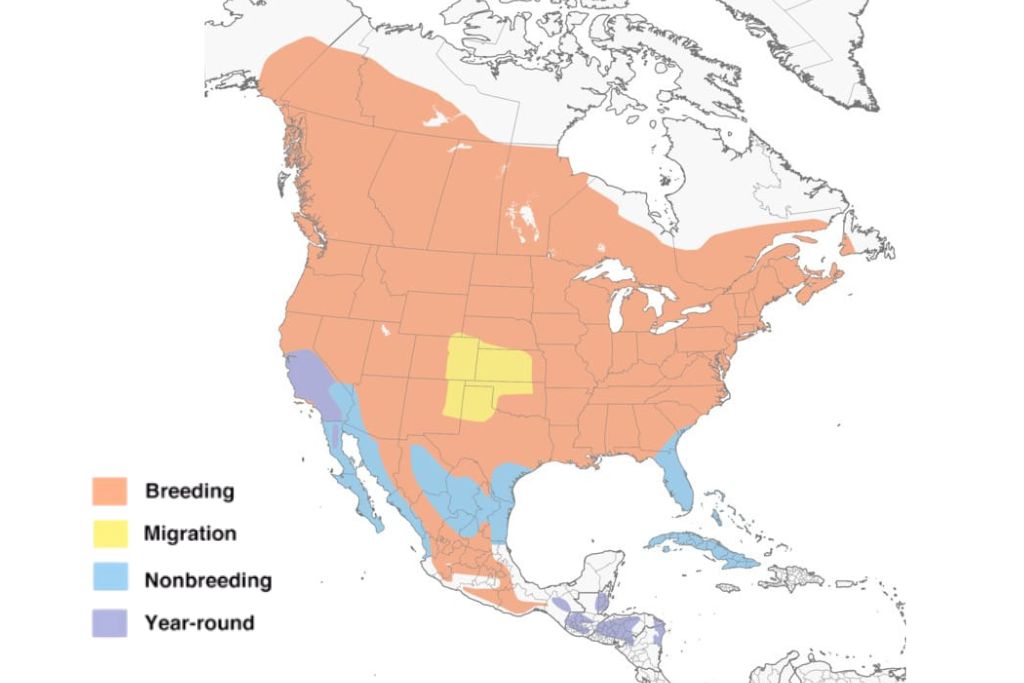
12. Downy Woodpecker
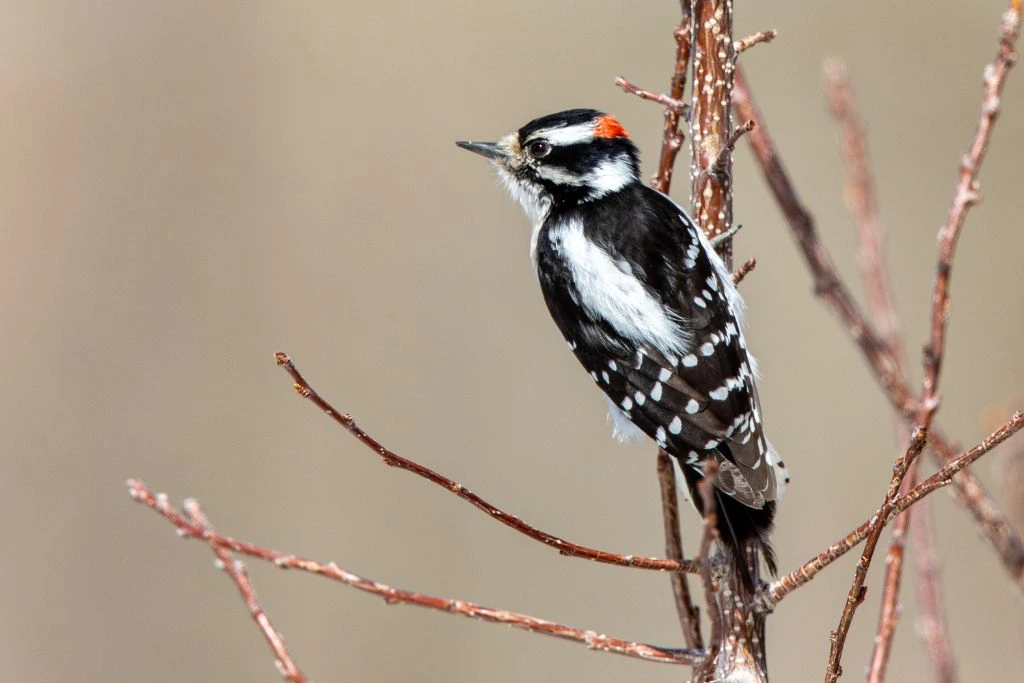
- Kingdom: Animalia
- Phylum: Chordata
- Class: Aves
- Order: Piciformes
- Genus: Dryobates
- Species: D. pubescens
The downy woodpecker (Dryobates pubescens) is North America’s smallest woodpecker, measuring 6 to 7 inches. It features a black and white plumage pattern, with a striking white belly and back, complemented by bold black wings marked with white spots.
The male downy woodpecker displays a small red patch on the back of its head, while the female lacks this marking. They use their strong, chisel-like bill to excavate tree bark and drill into wood to find insects and larvae. As it climbs tree trunks and branches, the bird’s zygodactyl feet, with two toes forward and two backward, give excellent grip and balance.
In Florida, they are commonly found in deciduous and mixed forests and suburban areas with mature trees. These adaptable birds can be seen feeding insects on backyard trees and shrubs or exploring trees near residential areas.
Despite their small size, they make a robust and distinctive drumming sound for communication. Due to their versatility and effective foraging, these woodpeckers live up to 12 years in the wild.
The downy woodpecker and the larger hairy woodpecker are closely related, and the two species might be confused.
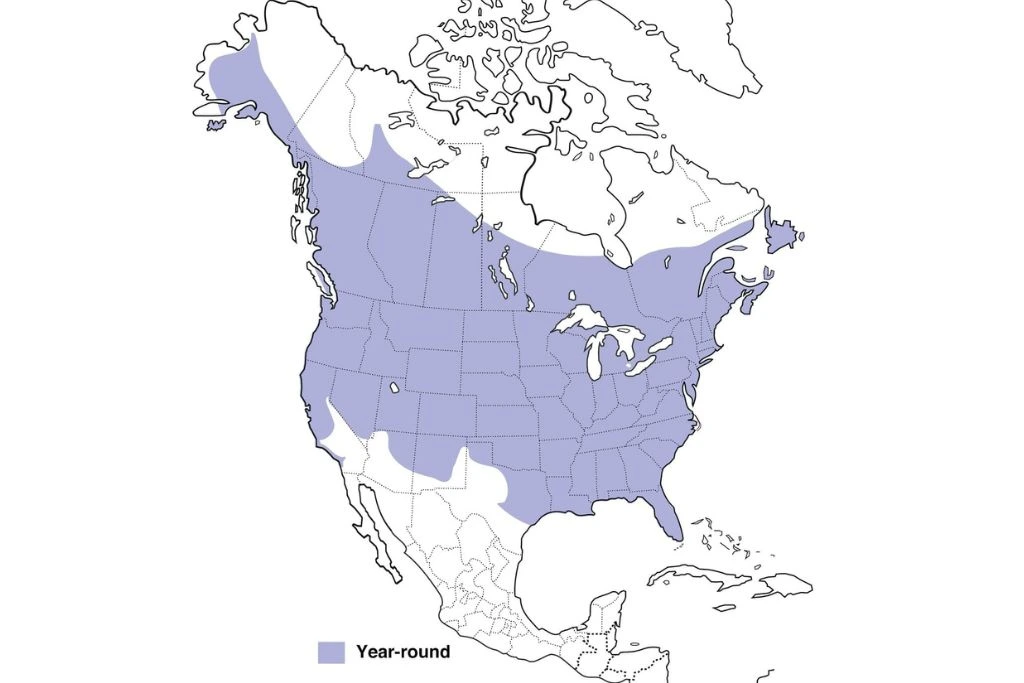
13. European Starling
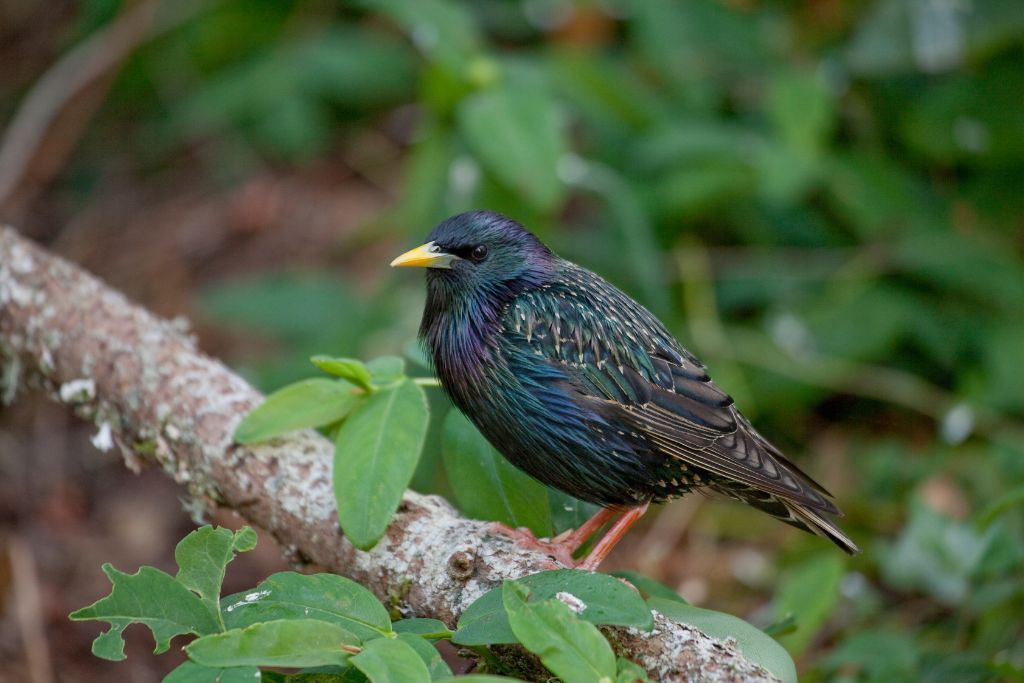
- Kingdom: Animalia
- Phylum: Chordata
- Class: Aves
- Order: Passeriformes
- Genus: Sturnus
- Species: S. vulgaris
The European starling (Sturnus vulgaris) is a medium-sized songbird that belongs to the family Sturnidae. This bird measures approximately 8 to 9 inches long and has a wingspan of about 12 to 16 inches. Their glossy black feathers have iridescent purple and green hues during the breeding season.
Adult European starlings have distinctive yellow beaks and yellow eyes, which contrast beautifully against their dark feathers. These birds form unique sky patterns called murmurations by swooping and gliding in large flocks.
Originally native to Europe, Asia, and North Africa, they were introduced to North America in the 19th century. One of their remarkable adaptations is their ability to adjust their feeding habits based on the available food sources. Their diet primarily consists of insects, fruits, berries, and seeds.
Cavity nesters, like European starlings, nest in tree hollows, buildings, and nest boxes. These birds are known for their aggressive behavior in nesting, often out-competing native cavity-nesting species. They line cup-shaped nests with feathers and moss using grass, twigs, and other plant materials.
Their lifespan averages about 3 to 4 years in the wild. They can be spotted throughout the state of Florida. You will likely find them foraging in open fields, parks, gardens, and around human structures like barns and rooftops.
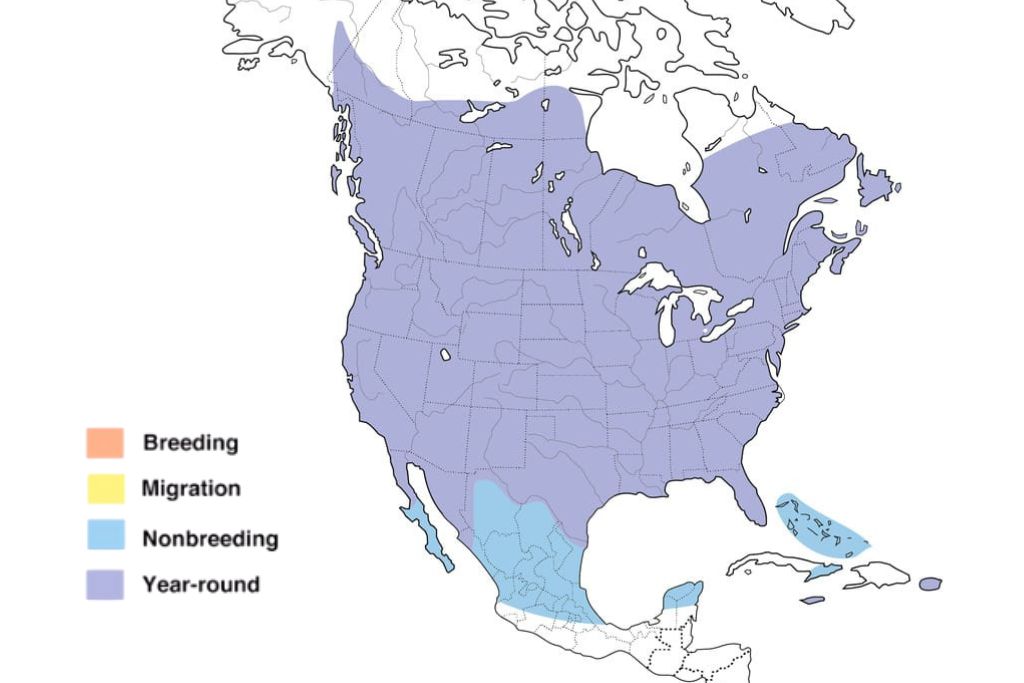
14. Eastern Bluebird
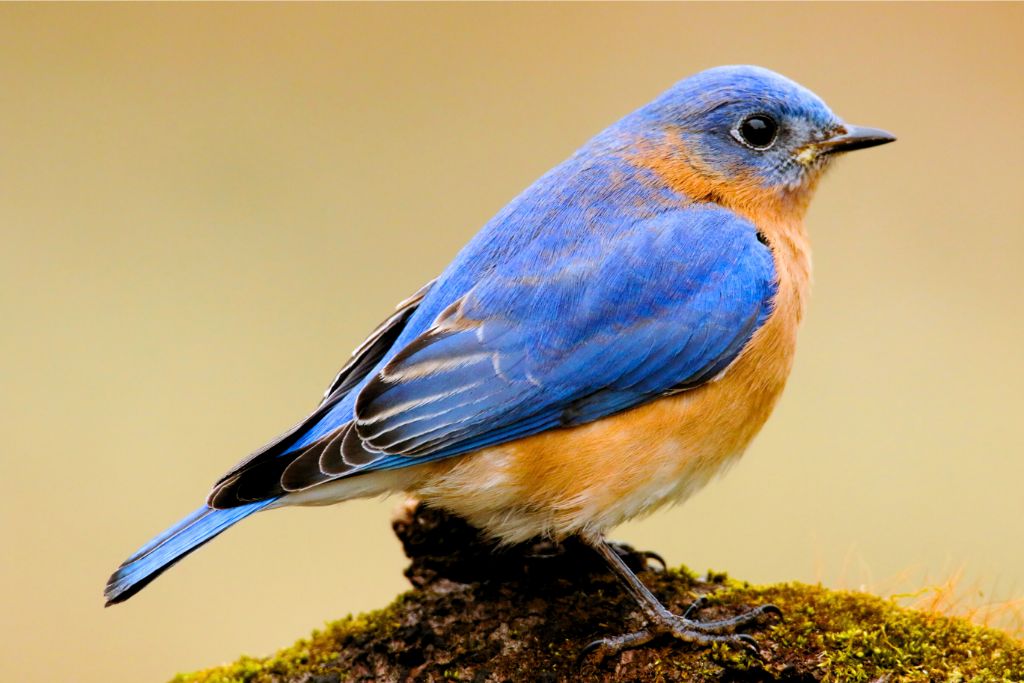
- Kingdom: Animalia
- Phylum: Chordata
- Class: Aves
- Order: Passeriformes
- Genus: Sialia
- Species: S. sialis
Eastern bluebirds’ (Sialia sialis) azure-blue upper parts, reddish-brown breasts, and white bellies captivate birdwatchers and environmentalists. These birds prefer open woodlands, meadows, and grassy areas with scattered trees.
They are often found perched on wires or fence posts, scanning their surroundings for insects, their primary food source. The ability of the eastern bluebird to detect prey at a distance is a unique adaptation. Their sharp, binocular vision allows them to accurately detect small insects on the ground, enabling successful foraging.
These birds have a relatively long life expectancy. On average, eastern bluebirds can live up to 6 to 10 years. Their presence is not limited to a particular region, as they can be spotted in various parts of Florida. They are also seen in suburban homes, parks, and golf courses.
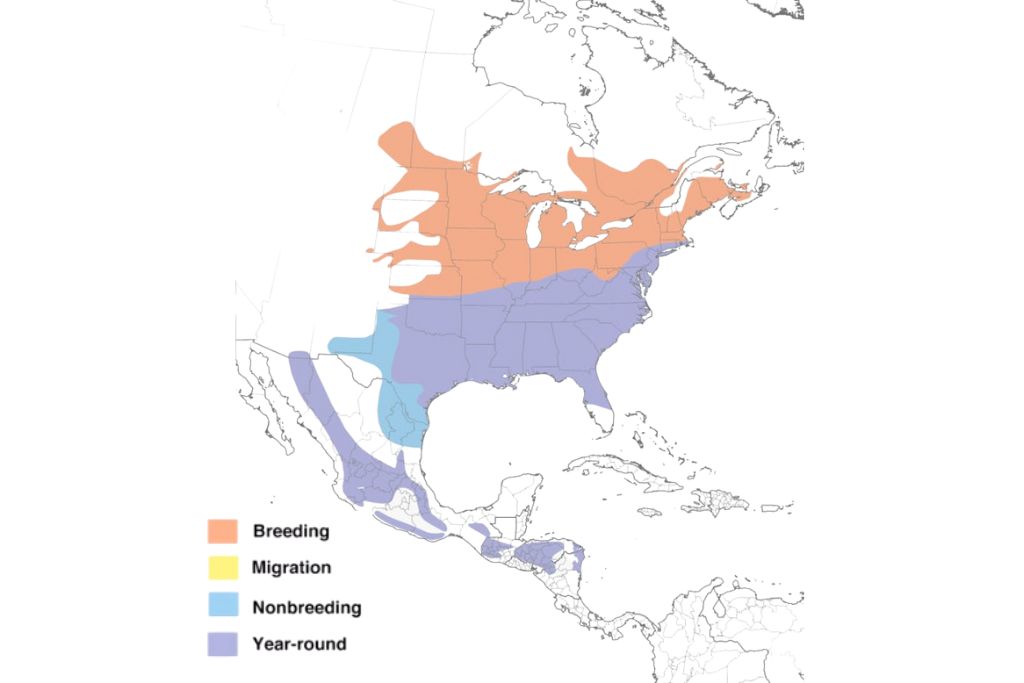
15. Gray Catbird
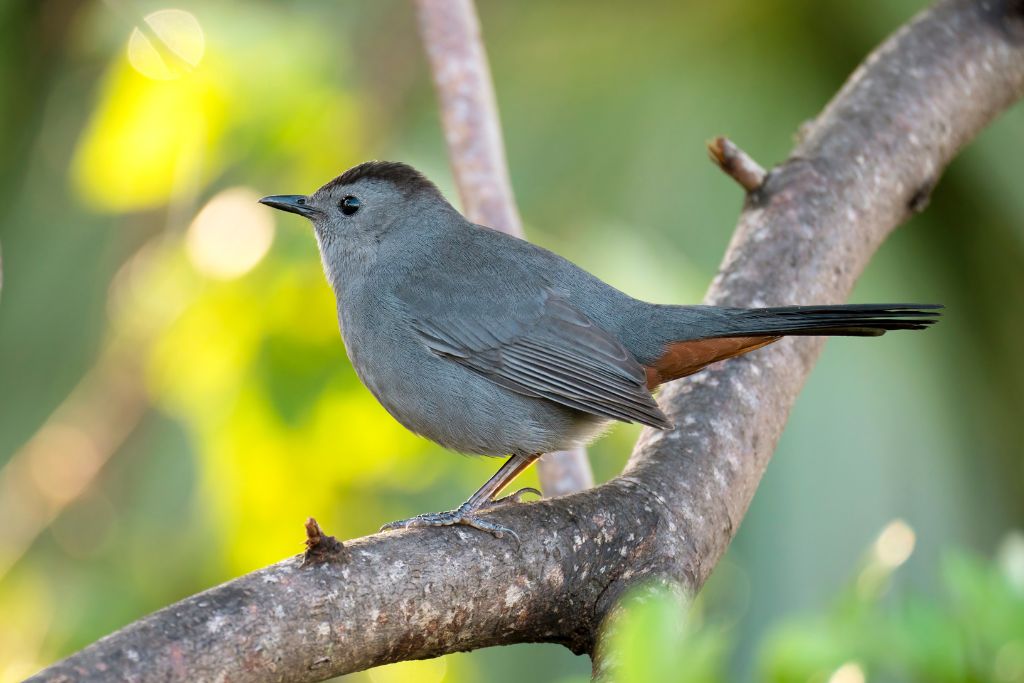
- Kingdom: Animalia
- Phylum: Chordata
- Class: Aves
- Order: Passeriformes
- Genus: Dumetella
- Species: D. carolinensis
The gray catbird (Dumetella carolinensis) is a fascinating bird known for its melodic songs and distinctive appearance. This medium-sized songbird attracts birdwatchers and nature lovers with its sleek gray plumage, black cap, and rufous undertail.
One notable adaptation of the gray catbird is its ability to mimic the sounds of other birds and even non-avian sounds. It mimics cat meows and bird calls like the northern flicker and eastern towhee. This skill allows the gray catbird to defend its territory and communicate with other birds in a unique and versatile way.
They can be found in various habitats, including woodlands, thickets, and shrubby areas. It prefers dense vegetation and ample cover, where it can forage for food and build its nest. In Florida, they are commonly spotted in coastal and inland regions, including parks, gardens, and nature reserves.
In terms of life expectancy, gray catbirds have an average lifespan of around 3 to 6 years in the wild. Some individuals have been known to live up to 10 years. Despite these challenges, their population remains steady and fascinates birdwatchers with its unusual songs and antics.
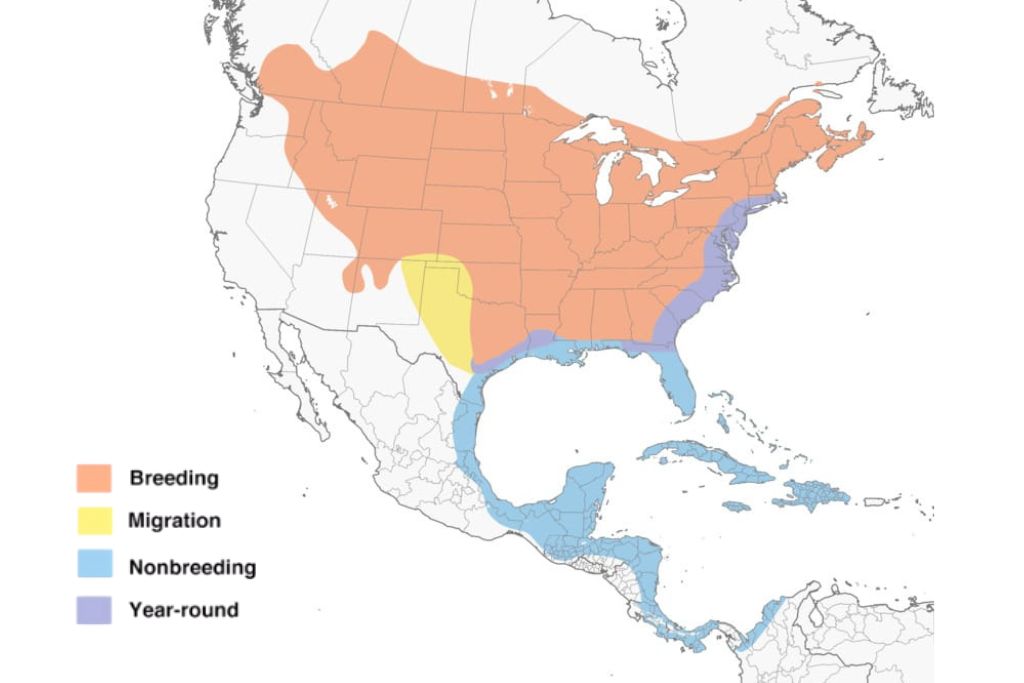
16. Hairy Woodpecker
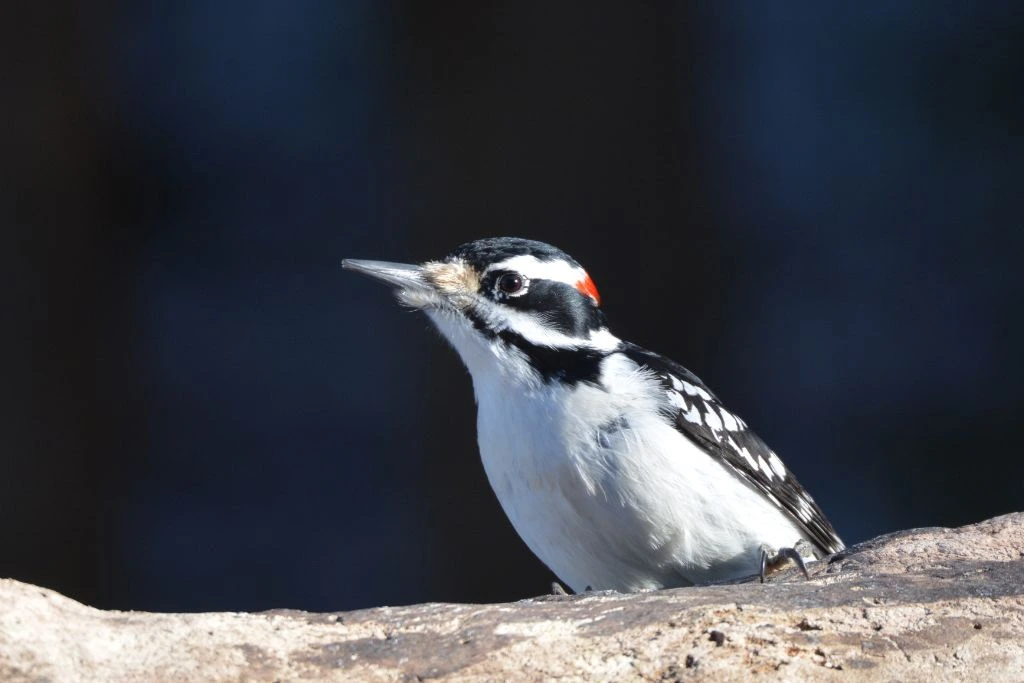
- Kingdom: Animalia
- Phylum: Chordata
- Class: Aves
- Order: Piciformes
- Genus: Leuconotopicus
- Species: L. villosus
The dashing hairy woodpecker (Leuconotopicus villosus) has black and white plumage. The male and female specimens share similar markings, with the males displaying a vibrant red patch on the back of their heads.
These woodpeckers are slightly larger than their near relative, at 9 to 10 inches. Their sharp, chisel-like beaks are perfectly designed for drilling into trees, allowing them to forage for insects and extract sap with ease.
Their stiff tail feathers provide excellent support, enabling them to cling to vertical surfaces like tree trunks. This bird’s unique skull has protective plates that shield its brains from their intense pecking. These adaptations help them dig tree bark and communicate through rhythmic drumming.
They thrive in mature deciduous and mixed forests with lots of dead wood for nesting and feeding. Look for them among towering oaks, hickories, and pines as they tirelessly explore tree trunks in search of insects and larvae. These lovely birds thrive in Florida’s woodlands, especially in the north and center of the state.
In the wild, these birds live 5 to 6 years, although some can live up to 12. They are not migratory birds but may exhibit limited seasonal movements in search of food and suitable habitats.
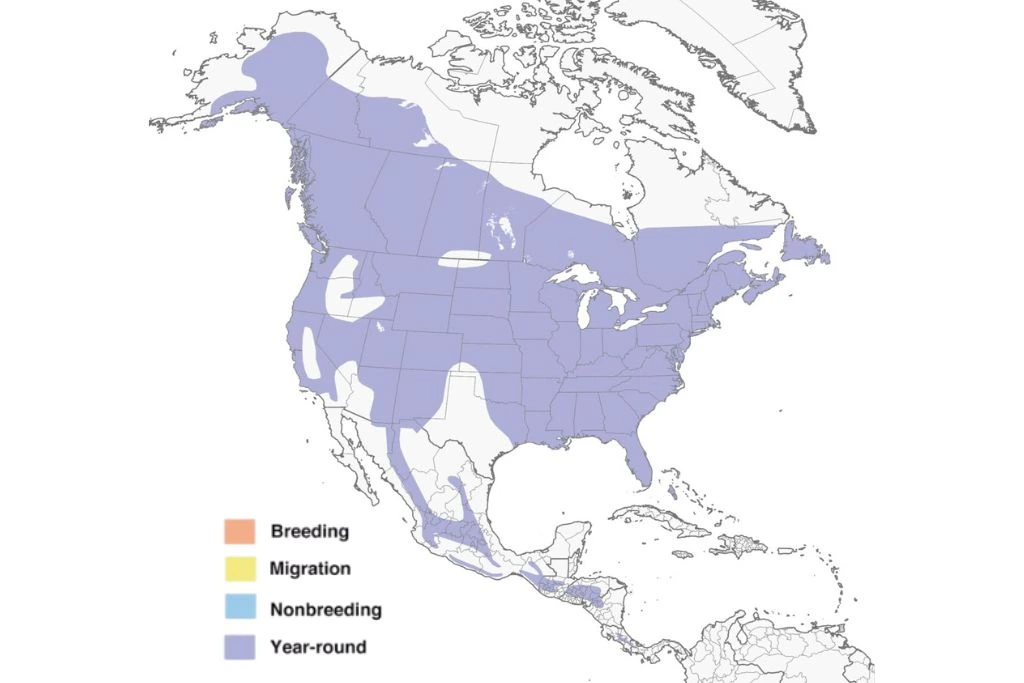
17. House Sparrow
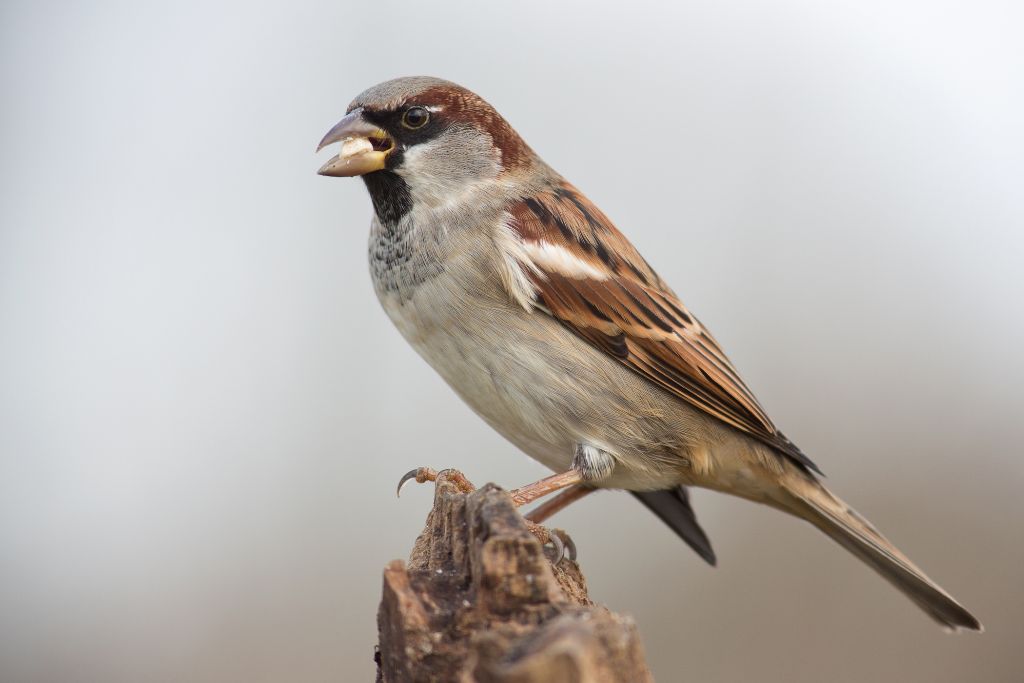
- Kingdom: Animalia
- Phylum: Chordata
- Class: Aves
- Order: Passeriformes
- Genus: Passer
- Species: P. domesticus
The house sparrow (Passer domesticus) is a small bird known for its lively presence and distinctive chirping. The house sparrow’s short tail, robust bill, and plump body help it survive. Females are brown and gray, while males have a chestnut crown and black bib.
These birds have sharp beaks that are perfectly designed for cracking open seeds and consuming various grains, fruits, and even insects. Their strong, agile feet enable them to perch effortlessly on various surfaces, including branches, ledges, and buildings.
House sparrows are well-adapted to life in and around human settlements. They can adapt their eating and breeding habits to the resources available. You can find house sparrows in many habitats, from bustling cities to suburban gardens, parks, and farmlands.
Their life expectancy is 3 to 4 years, yet they can live up to 10 years in good conditions. They are found in Florida’s urban, residential, park, and garden environments. Their lively hopping and enthusiastic chirping offer excitement and vibrancy to the atmosphere.
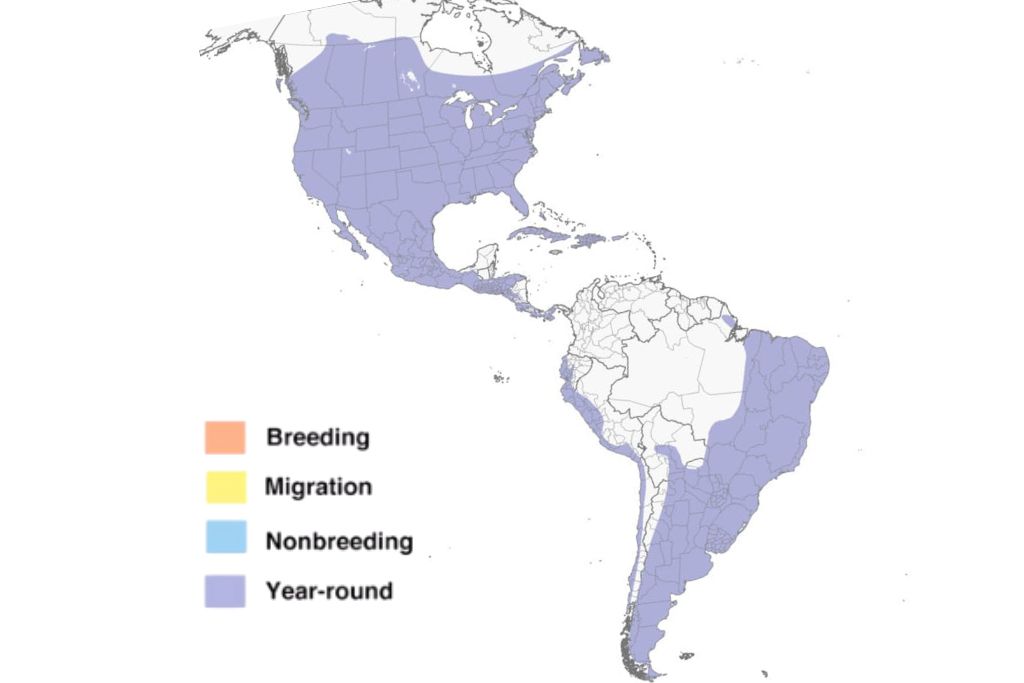
18. House Finch
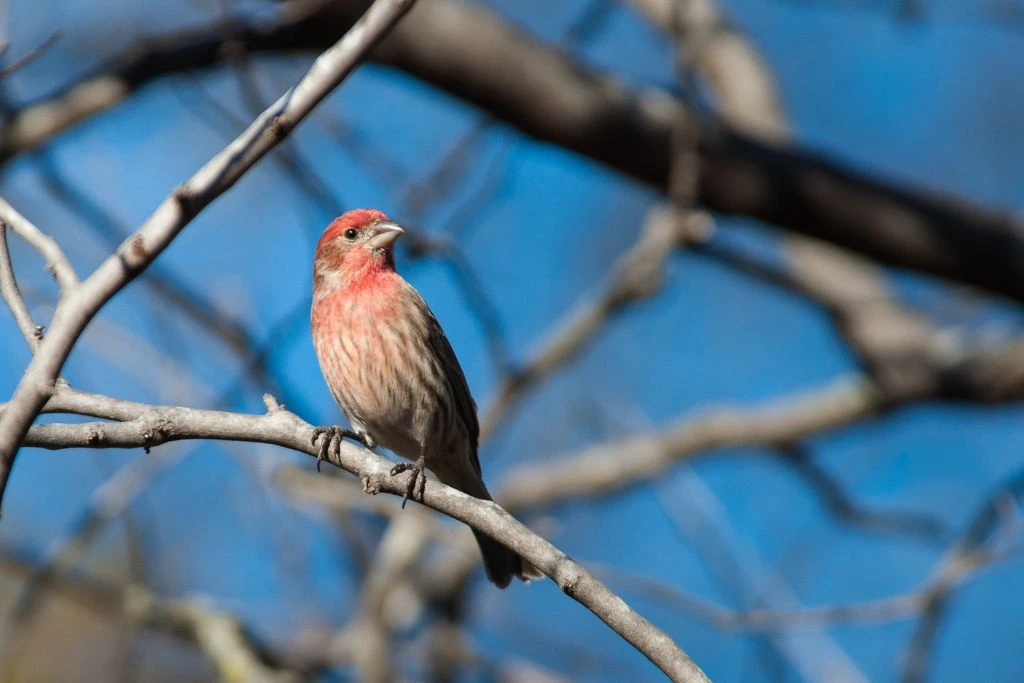
- Kingdom: Animalia
- Phylum: Chordata
- Class: Aves
- Order: Passeriformes
- Genus: Haemorhous
- Species: H. mexicanus
The house finch (Haemorhous mexicanus) brightens our communities with its beautiful colors and sweet singing. They are a bird lover’s joy with their distinctive red plumage on males and faint brown tones on females.
These adaptable birds can be found in urban areas, suburban neighborhoods, forests, and deserts. They thrive in human-altered environments and are skilled at making the most of what they have. They are excellent at obtaining food and shelter near residential areas and often sit on tree branches, fence lines, or bird feeders.
House finches have a short lifespan, with most living 5 years or less. They are found across Florida but are most common in residential settings with lots of greenery and bird feeders or flowering plants.
Their adaptability, vibrant plumage, and delightful songs make them treasured visitors to our local bird populations. Enjoy these gorgeous birds and the beauties of the avian world they represent.
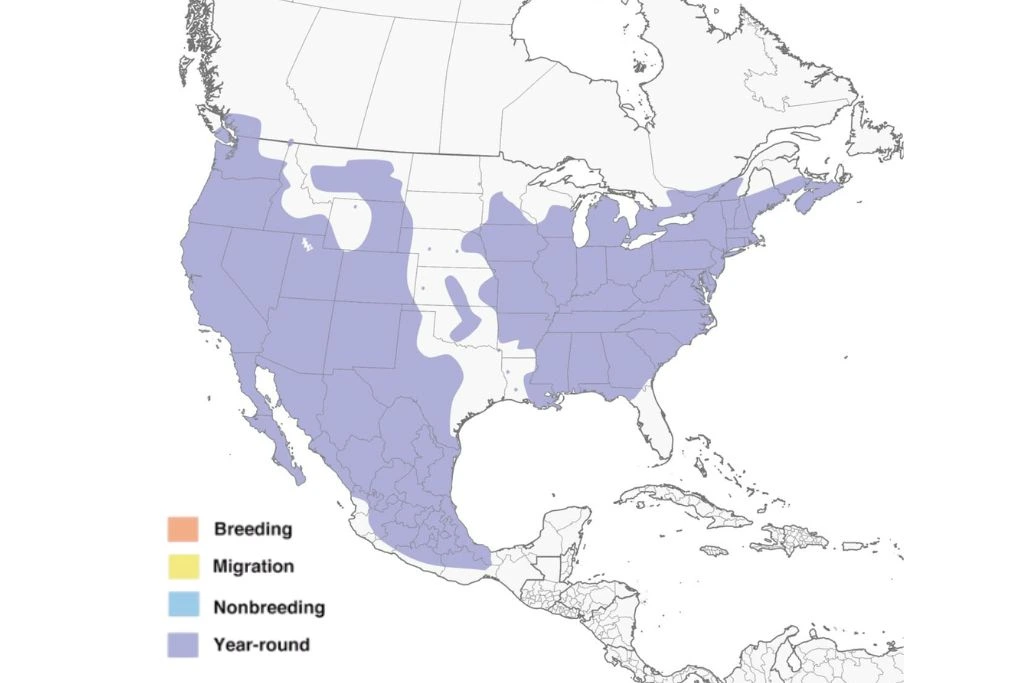
19. House Wren
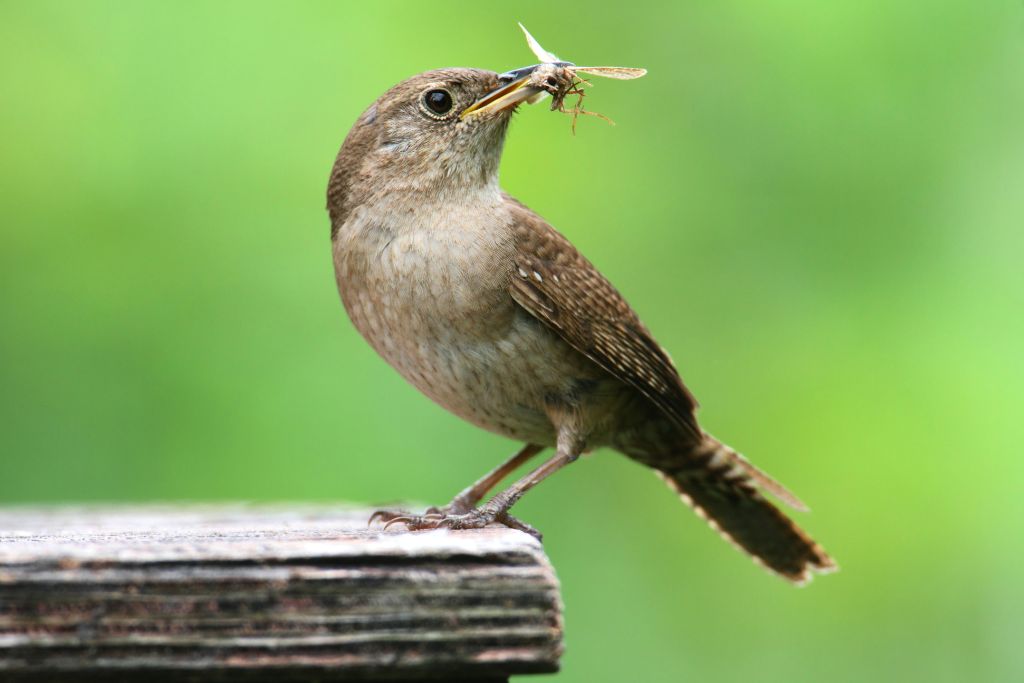
- Kingdom: Animalia
- Phylum: Chordata
- Class: Aves
- Order: Passeriformes
- Genus: Troglodytes
- Species: T. aedon
The lovely house wren (Troglodytes aedon) can fascinate any nature lover. It is 4.3 inches long and weighs 0.3 to 0.4 ounces. It has a plump body, short wings, and an erect tail. With darker streaks on its back and a lighter underbelly, its plumage is a gorgeous brown mix.
Male and female house wrens look alike, making it hard to tell them apart. Its slender beak allows it to explore crevices and cracks in search of insects, its primary food source. Its loud, beautiful song allows it to communicate and defend its territory.
These delightful birds typically inhabit a variety of forested habitats, such as woodlands, parks, and gardens across Florida. In the state’s rich foliage and diverse ecosystems, they thrive in the central and northern regions. They prefer dense shrubbery, as it provides ample cover and a rich source of insects.
House wrens are highly migratory, traveling long distances during winter migration to Central and South America. Despite their small size, they have an impressive life expectancy, with some individuals reaching up to 6 years of age. They have also been seen “anting” their feathers, possibly repelling parasites or soothing skin discomfort.
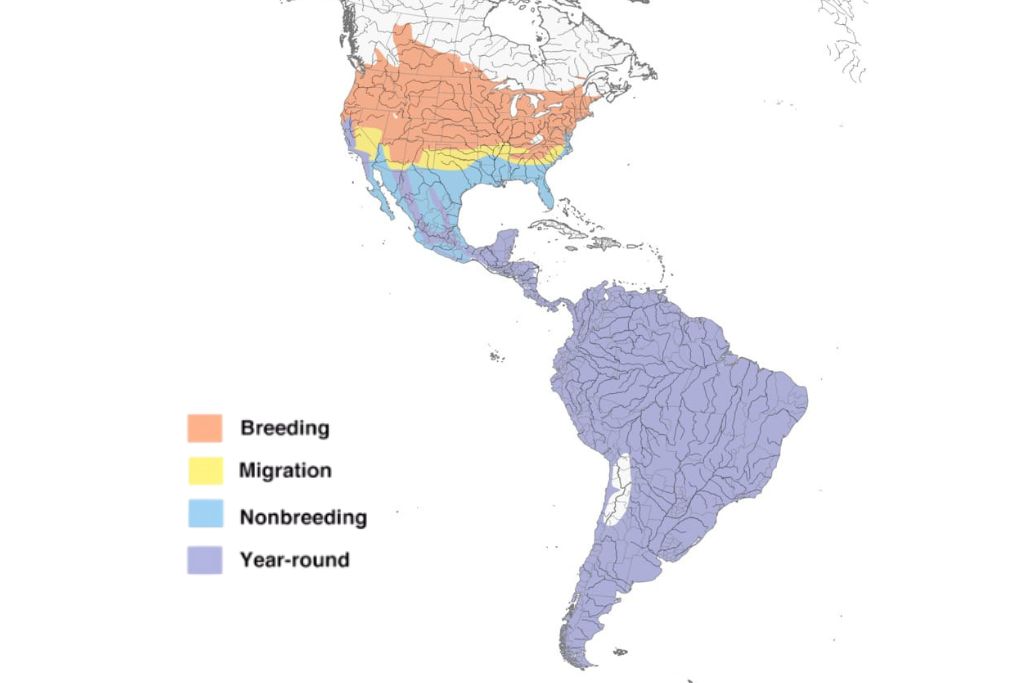
20. Nighthawk
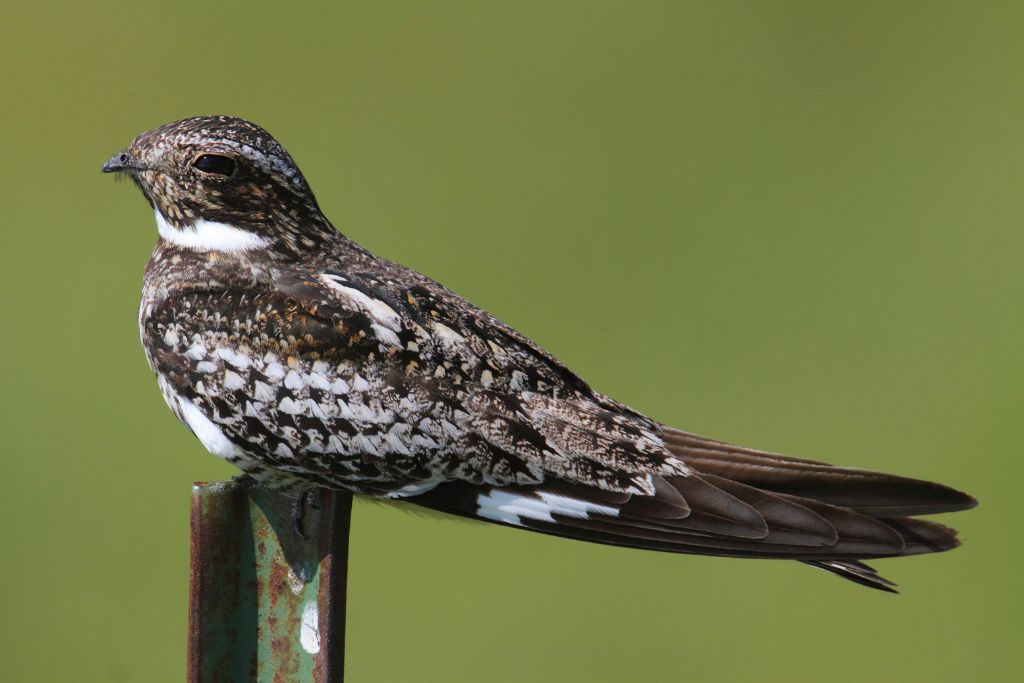
- Kingdom: Animalia
- Phylum: Chordata
- Class: Aves
- Order: Caprimulgiformes
- Genus: Chordeiles
- Species: C. minor
Nighthawks (Chordeiles minor), frequently mistaken for bats, are elusive birds with unique traits. Its sleek, slender form lets it move quickly through the night sky. With a wingspan reaching up to 24 inches, it effortlessly glides through the air, thanks to its long, tapered wings.
Its cryptic brown, black, and gray plumage camouflages well in dark and daybreak. Its large, wide mouth is lined with bristles, allowing it to capture insects on the wind with remarkable precision. They prefer to roost on tree branches or ledges due to their short legs and small feet.
The nighthawk has a relatively short life expectancy of about 4 to 5 years. It migrates from its North American breeding sites to Argentina for the winter. These mysterious birds are known for their “booming” sounds, resembling a distant peent.
In Florida, nighthawks are typically spotted in open habitats, such as grasslands, prairies, and coastal areas. They can often be seen soaring gracefully through the sky as they search for their insect prey during the twilight hours. Keep your eyes open, especially at twilight and dawn, to see these captivating creatures fly over the Floridian skies.
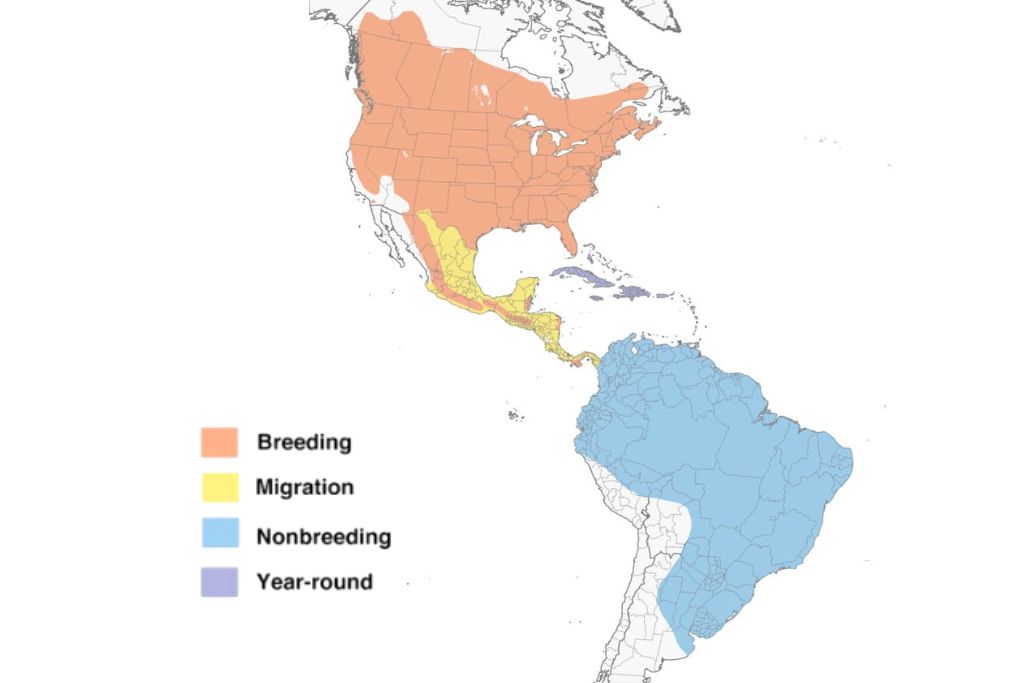
21. Northern Cardinal
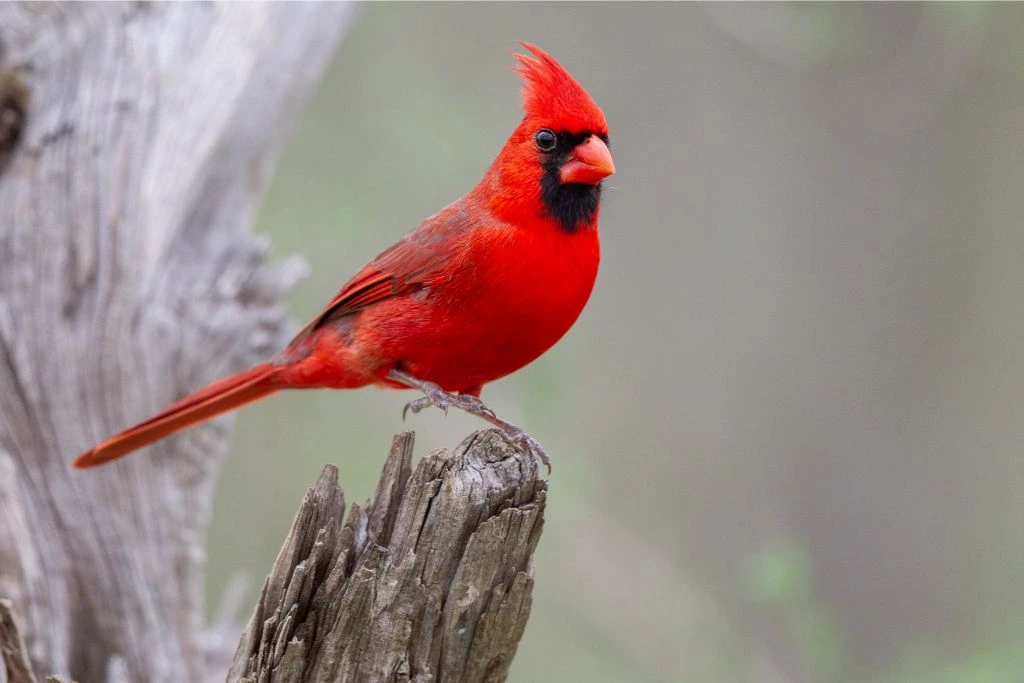
- Kingdom: Animalia
- Phylum: Chordata
- Class: Aves
- Order: Passeriformes
- Genus: Cardinalis
- Species: C. cardinalis
The northern cardinal (Cardinalis cardinalis) is a vibrant and captivating bird with a prominent place in the avian world. Females are reddish-brown, while males have vivid red bodies and black facial masks. These gorgeous birds are found across North America and are one of the most loved bird species.
Their strong beaks are built to crack seeds and eat a variety of fruits, making them versatile feeders. These birds possess strong leg muscles that aid in hopping between branches and foraging on the ground. Their widespread distribution across North America is due to their adaptability to varied conditions, from deep woods to urban areas.
Northern cardinals can live up to 15 years in the wild, but the typical lifespan is 3. In Florida, they are common in woodlands, gardens, and suburban areas. As they establish territories and communicate, these beautiful birds sing melodiously through the woods.
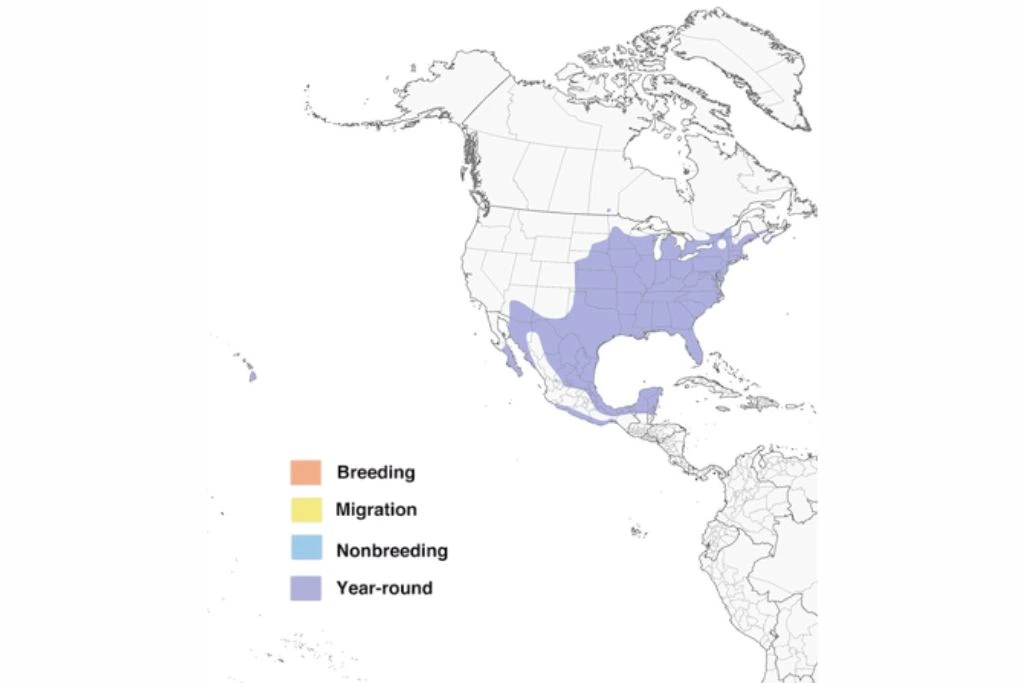
22. Northern Mockingbird
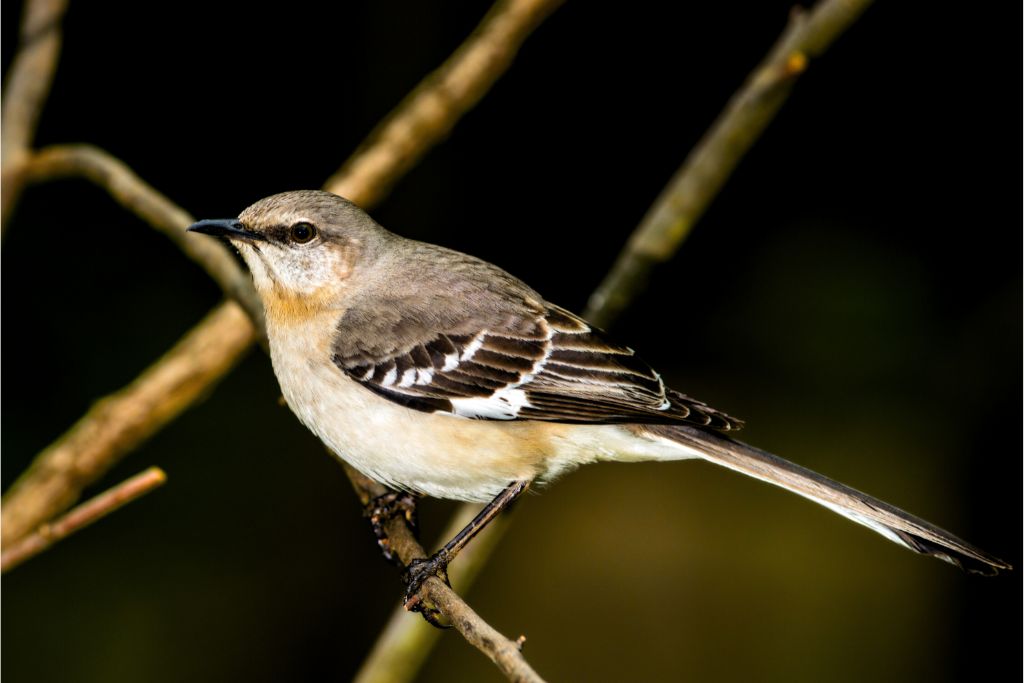
- Kingdom: Animalia
- Phylum: Chordata
- Class: Aves
- Order: Passeriformes
- Genus: Mimus
- Species: M. polyglottos
The beautiful northern mockingbird (Mimus polyglottos) is slim and has lovely gray plumage. Its long tail and slender beak perfectly complement its distinctive appearance.
Its ability to mimic other birds’ songs is extraordinary. This charming songster is an avian virtuoso, mimicking anything from chirping melodies to neighboring species’ songs.
These adaptable birds can be found in urban areas, suburban gardens, open woodlands, and parks. They relocate to warmer climates in winter, proving their adaptability. Such adaptability allows them to flourish in different landscapes, spreading their musical repertoire wide.
With an average life expectancy of around 8 to 10 years, these birds can live relatively long lives in the wild.
As for their presence in Florida, Northern Mockingbirds can be spotted throughout the state, from the coastal areas to inland regions. Their love of open spaces and shrubby habitats makes them widespread in residential neighborhoods, parks, and gardens. Watch for these melodious wonders during your Floridian adventures!
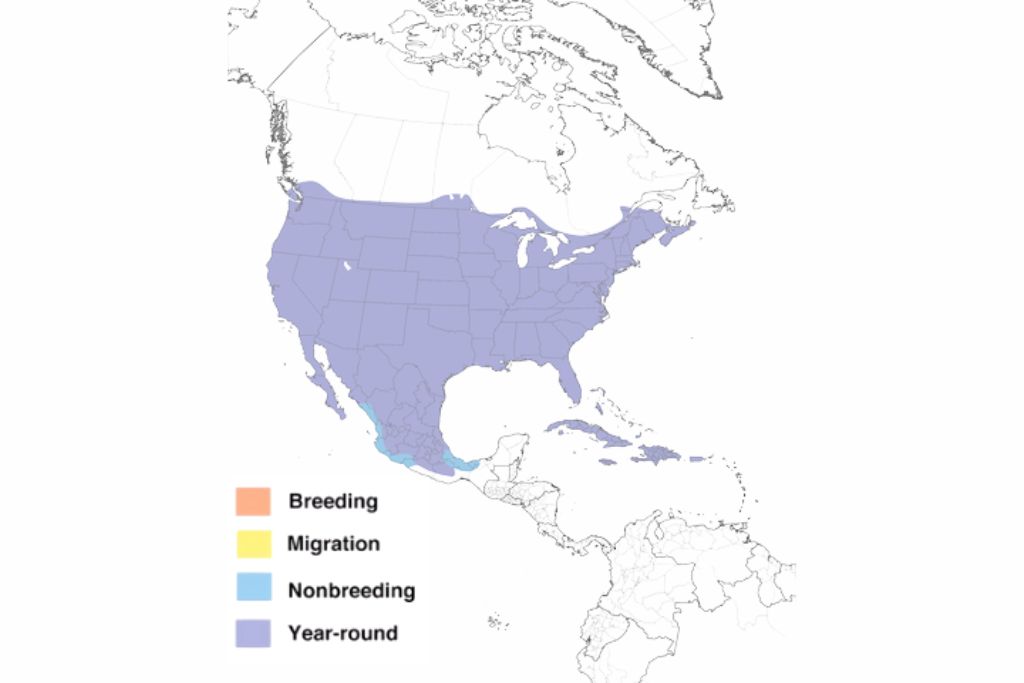
23. Mourning Dove
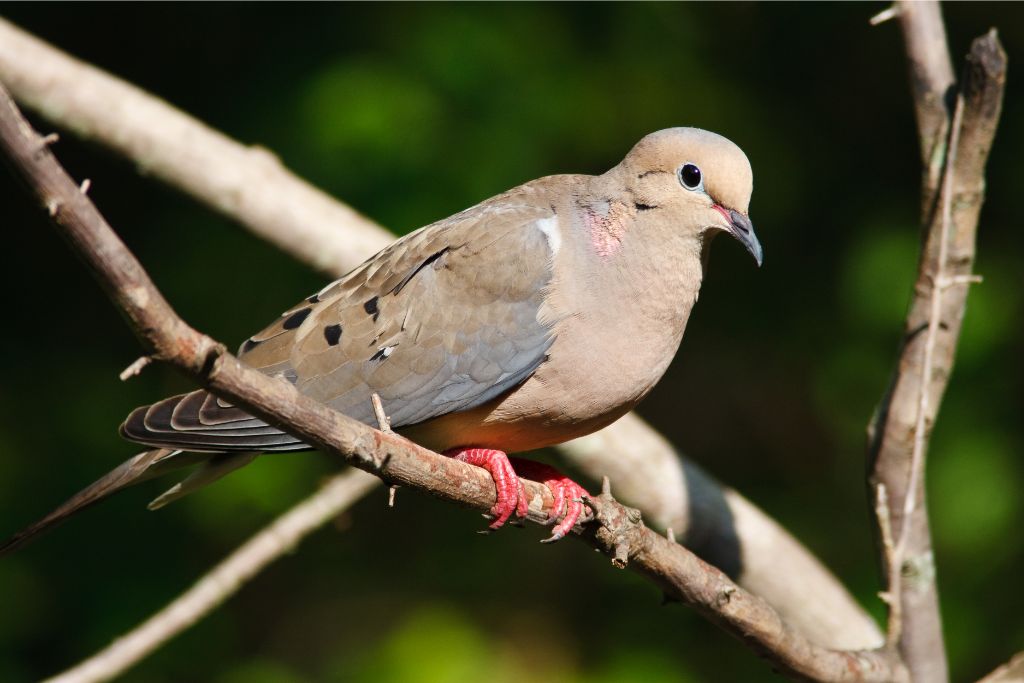
- Kingdom: Animalia
- Phylum: Chordata
- Class: Aves
- Order: Columbiformes
- Genus: Zenaida
- Species: Z. macroura
The mourning dove (Zenaida macroura) has a sleek, delicate frame and measures 9 to 13 inches. Its feathers are subdued browns and grays with iridescent patches on the neck and wings. One of its most distinguishing features is the tapered tail, adorned with a few white spots.
They possess powerful flight muscles, enabling them to swiftly navigate open areas with ease. Sucking allows these birds to drink from shallow puddles or bird baths efficiently. Their mournful cooing cry, which attracts mates and communicates, is their main adaptation.
Mourning doves are versatile in their habitat choice, as they can be found in various environments across Florida. From suburban gardens to woodlands and parks, these birds have adapted to live harmoniously with humans. They feed on seeds, grains, and insects on power lines, rooftops, and the ground.
These birds are one of the most widely hunted migratory birds in North America. Their robust and agile flight patterns make them a popular target for hunters. Some birds can live up to 13 years in the wild, which is a fantastic time.
In Florida, mourning doves are most often seen in grasslands, agricultural fields, and urban parks. Their presence is often marked by their gentle cooing calls and preference for perching on elevated structures.
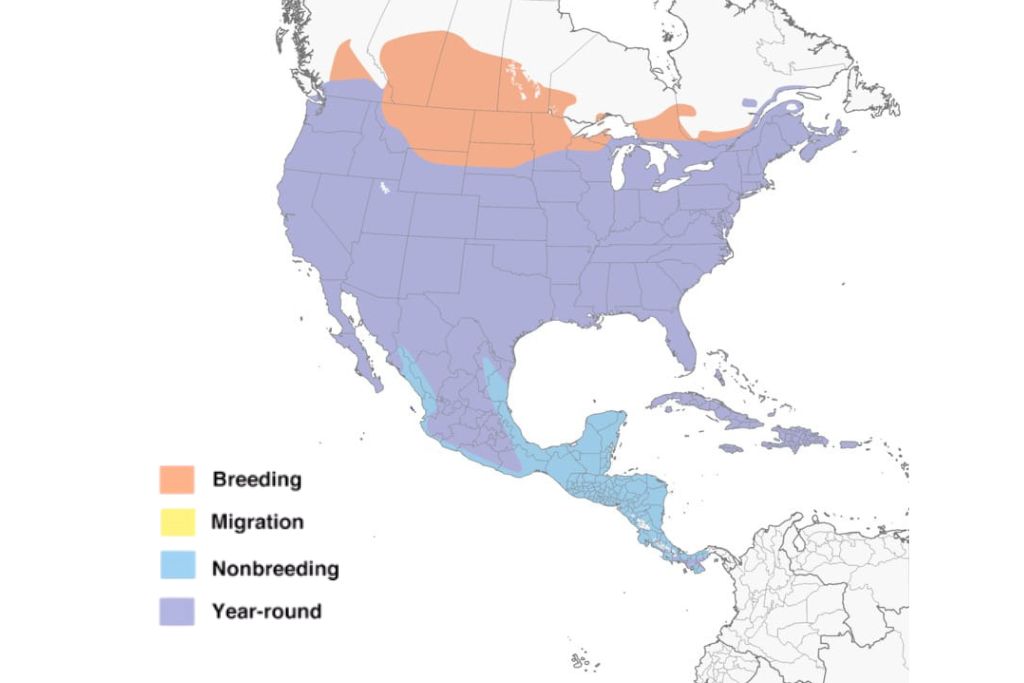
24. Palm Warbler
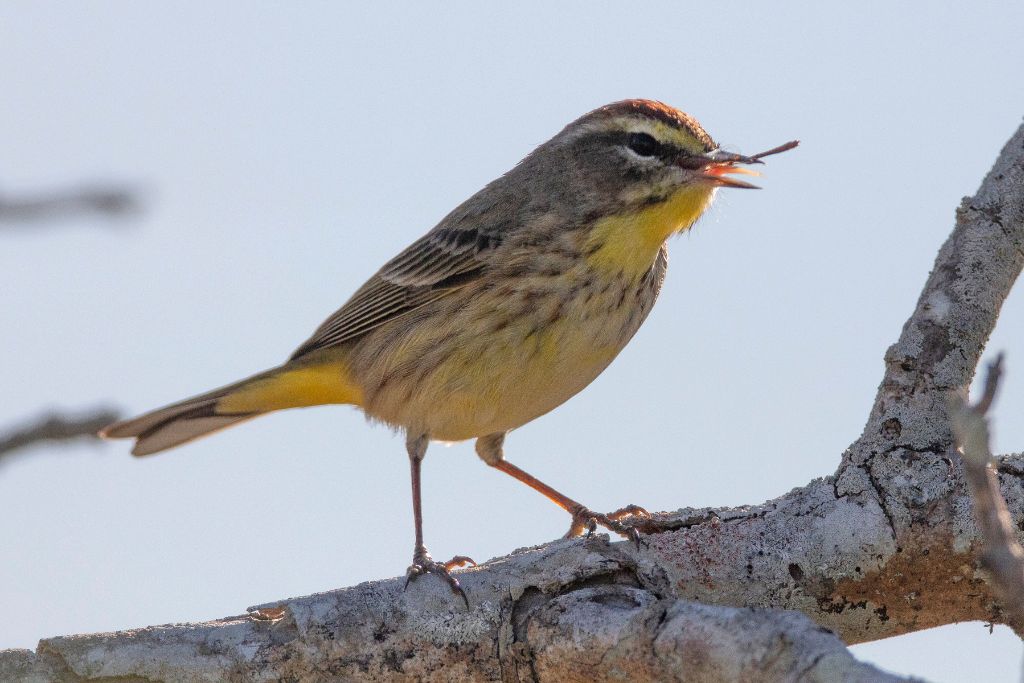
- Kingdom: Animalia
- Phylum: Chordata
- Class: Aves
- Order: Passeriformes
- Genus: Setophaga
- Species: S. palmarum
The palm warbler (Setophaga palmarum) is a charming little bird known for its distinctive appearance and lively behavior. This small warbler measures 5 to 6 inches long and has a wingspan of about 8 to 9 inches. Its plumage is a delightful blend of brown, olive, and yellow tones, with a bold rusty cap on its head.
One of its most eye-catching features is the constant wagging of its tail, which adds a touch of cheerfulness to its movements. They have successfully adapted to terrestrial and wetland environments, including forests, thickets, bogs, and marshes.
These warblers jump around, swinging their tails, looking for insects among fallen leaves and grass. This behavior is a clever adaptation to their preferred diet, consisting of insects, spiders, and small berries. Long legs and slender, sharp beaks help them catch prey in the undergrowth.
They get their name from waving their tails like palm fronds in the breeze. Another captivating characteristic is their distinctive call, which sounds like a sharp “tip” or a musical “chip.” During courtship, they flutter like butterflies, showing their agility and elegance.
The average lifespan of a palm warbler is around 4 to 6 years. In Florida, these lovely birds can be spotted during their migration, particularly in winter. They can be found in various habitats, including coastal areas, marshes, and woodland edges.
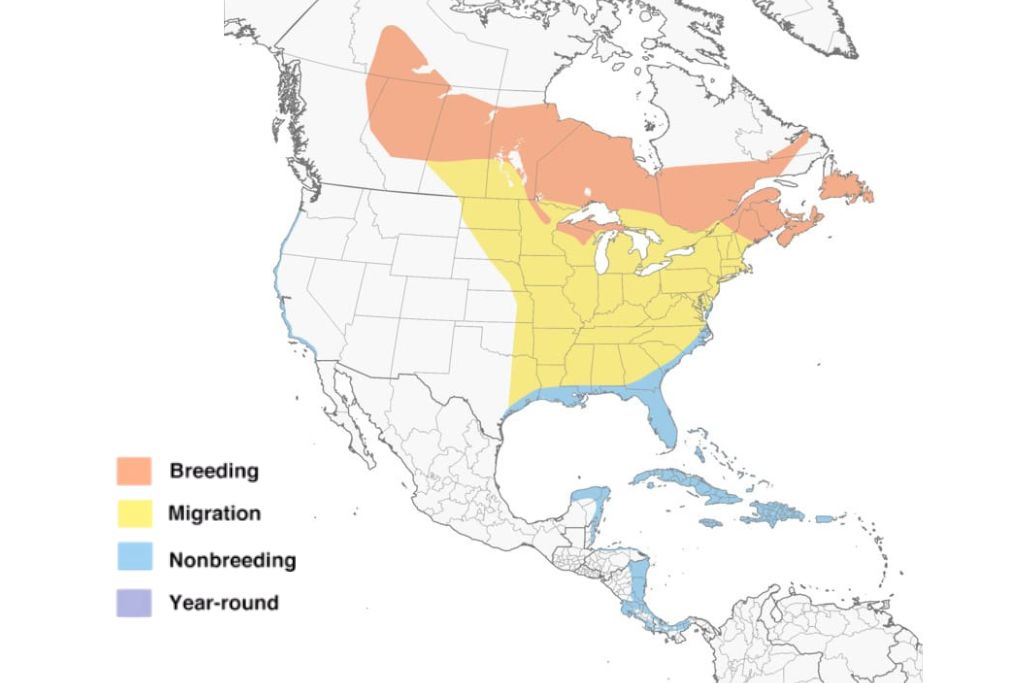
25. Pileated Woodpecker
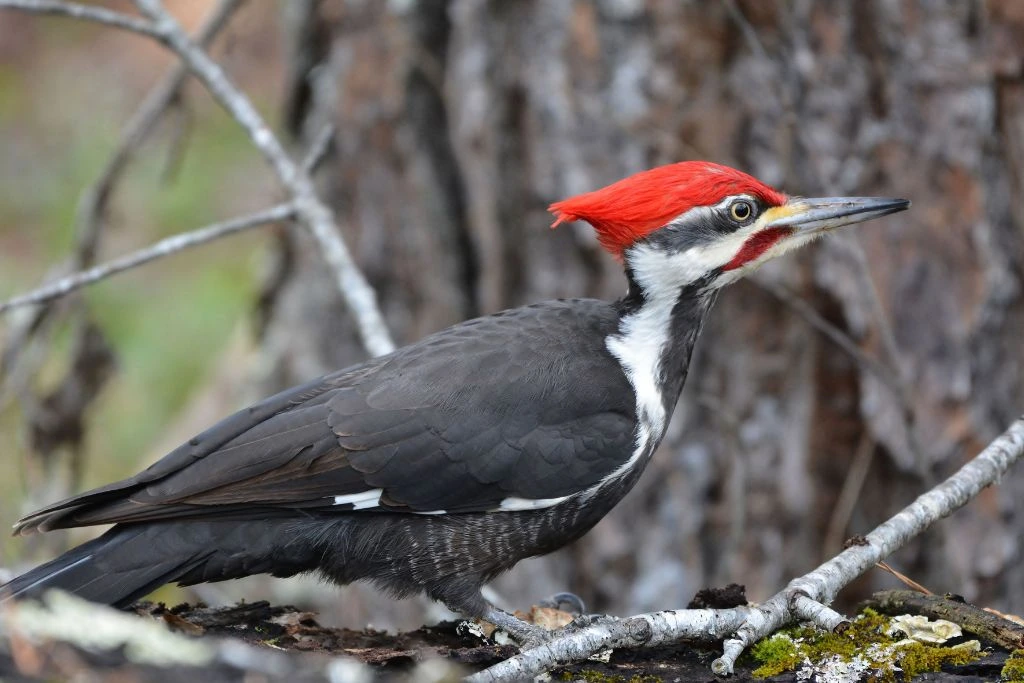
- Kingdom: Animalia
- Phylum: Chordata
- Class: Aves
- Order: Piciformes
- Genus: Dryocopus
- Species: D. pileatus
Known for its large size, the pileated woodpecker (Dryocopus pileatus) is one of the largest woodpecker species in North America. It measures about 16 to 19 inches long and has a wingspan of approximately 26 to 30 inches. This bird has a bright plumage with black feathers, white stripes around its neck, and a red crest.
They live in deciduous and mixed woodlands. This woodpecker is equipped with strong claws and stiff tail feathers and is well-suited for climbing and maneuvering on tree trunks. Its long tongue, extending up to 4 inches, aids in extracting ants, beetle larvae, and other insects from the wood.
These birds excavate deep cavities in dead or decaying trees for their nests. The males engage in drumming, a rhythmic pounding on trees, to establish territories and attract mates. Both parents actively participate in raising their young, taking turns incubating the eggs and caring for the hatchlings.
They have an average life expectancy of around 10 years in the wild, although some individuals can live up to 15 years. Pileated woodpeckers are often seen in Florida’s forested areas, particularly in the north and center. Their calls and drumming can often be heard in mature forests with large trees.
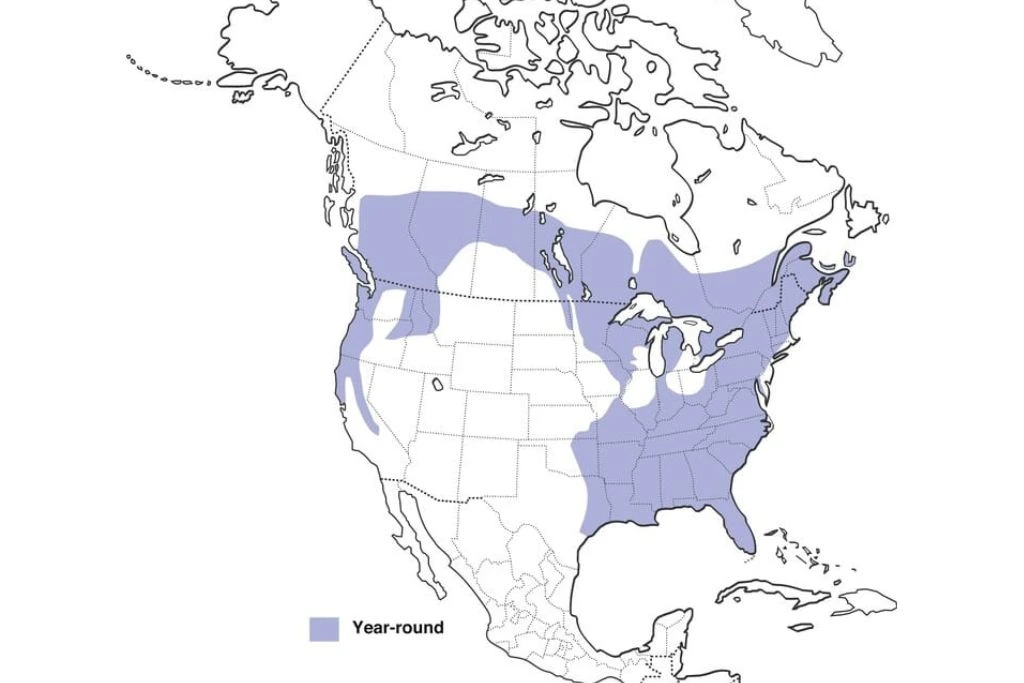
26. Red-Winged Blackbird
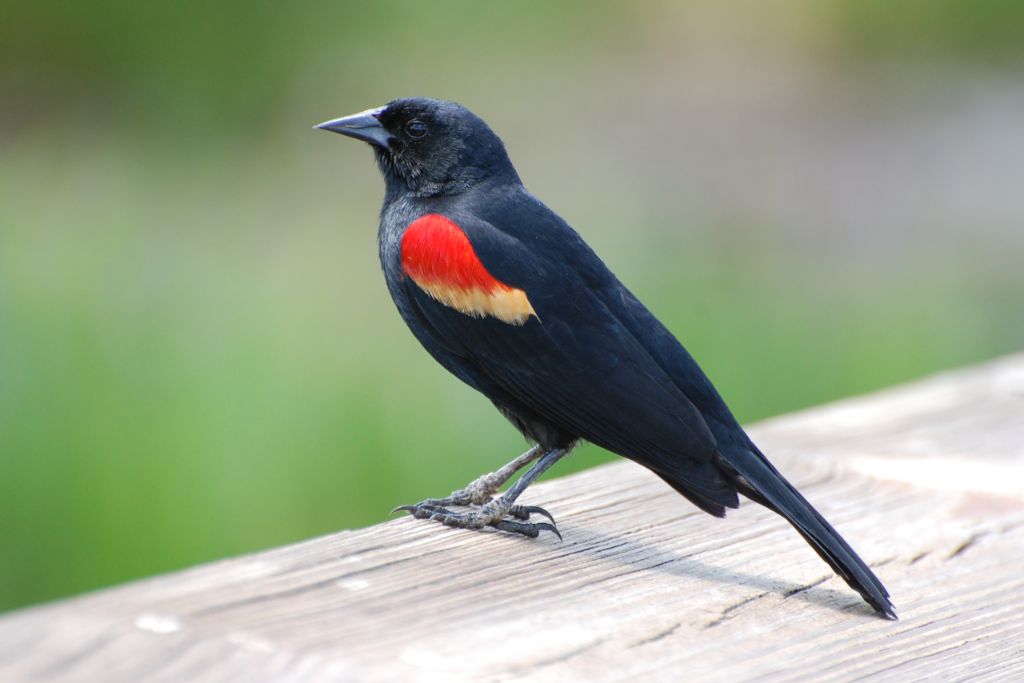
- Kingdom: Animalia
- Phylum: Chordata
- Class: Aves
- Order: Passeriformes
- Genus: Agelaius
- Species: A. phoeniceus
The red-winged blackbird’s (Agelaius phoeniceus) glossy black plumage and bright red and yellow shoulder patches make it easy to spot, especially in males. Courtship and territorial displays feature these patches, signaling potential mates and competitors. While nesting, females have darker brown feathers with lighter streaks for camouflage.
They live in wetlands, marshes, and along the edges of lakes, rivers, and ponds. They possess unique adaptations that enable them to thrive in these environments. Their large, pointed beaks are ideal for searching dirt and plants for insects, spiders, seeds, and small amphibians.
When it comes to nesting and breeding behaviors, the red-winged blackbird follows a fascinating pattern. Males defend their territories in early spring by perching on prominent foliage and singing their “conk-la-ree” song. Females build cup-shaped nests of grass, leaves, and other plant materials for protection.
With an average lifespan of 4 to 8 years, these birds can live up to 15 years in the wild. They are found in freshwater marshes, coastal wetlands, and suburban areas with enough vegetation in Florida.
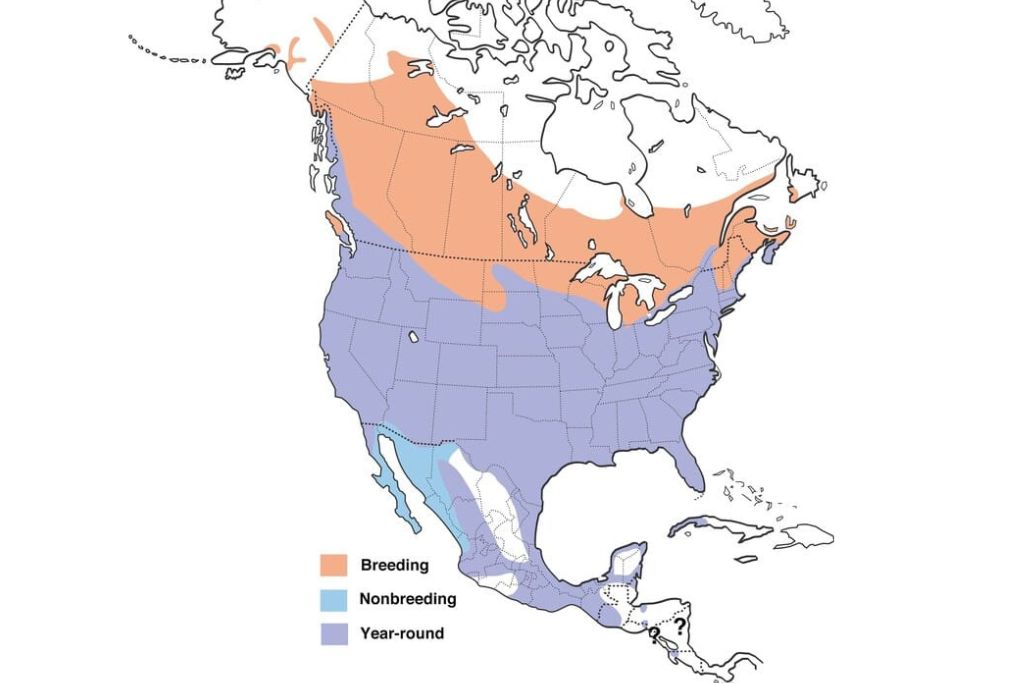
27. Red-Bellied Woodpecker
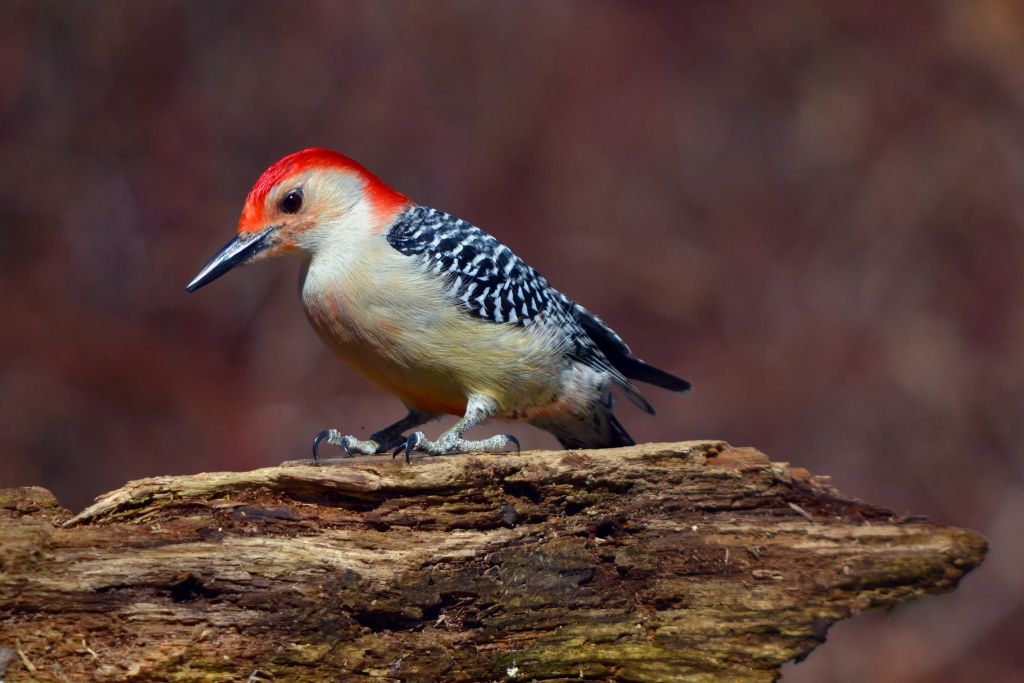
- Kingdom: Animalia
- Phylum: Chordata
- Class: Aves
- Order: Piciformes
- Genus: Melanerpes
- Species: M. carolinus
Red-bellied woodpeckers (Melanerpes carolinus) have shiny black backs and bold white bars. As the name suggests, its most distinctive feature is a vibrant red crown extending from the bill to the nape. Contrary to its name, the reddish tint on its belly is often hidden, making it a bit challenging to spot.
Its wingspan is 13 to 16 inches, and its length is 9 to 10 inches, making it a medium-sized woodpecker. Its strong bill, specifically designed for drilling into the bark, helps it extract insects, larvae, and sap from trees. While hanging onto tree trunks, their stiff tail feathers hold them vertically and horizontally.
They inhabit mature forests, woodlands, and suburban areas in the eastern US, including Florida. These woodpeckers are often seen in Florida parks, natural reserves, and neighborhoods with many trees. They prefer habitats with a mix of tall trees, providing both suitable foraging opportunities and potential nesting sites.
Despite their name, the red on their belly is often obscured by feathers, making it challenging to spot. Instead, their red crown and zebra-like back pattern steal the show. These woodpeckers communicate and display with a “whirr” sound.
They have an impressive lifespan, with some individuals living up to 12 years in the wild. They can be found in Florida’s lush panhandle woods and subtropical Everglades, where their plumage brightens the scenery.
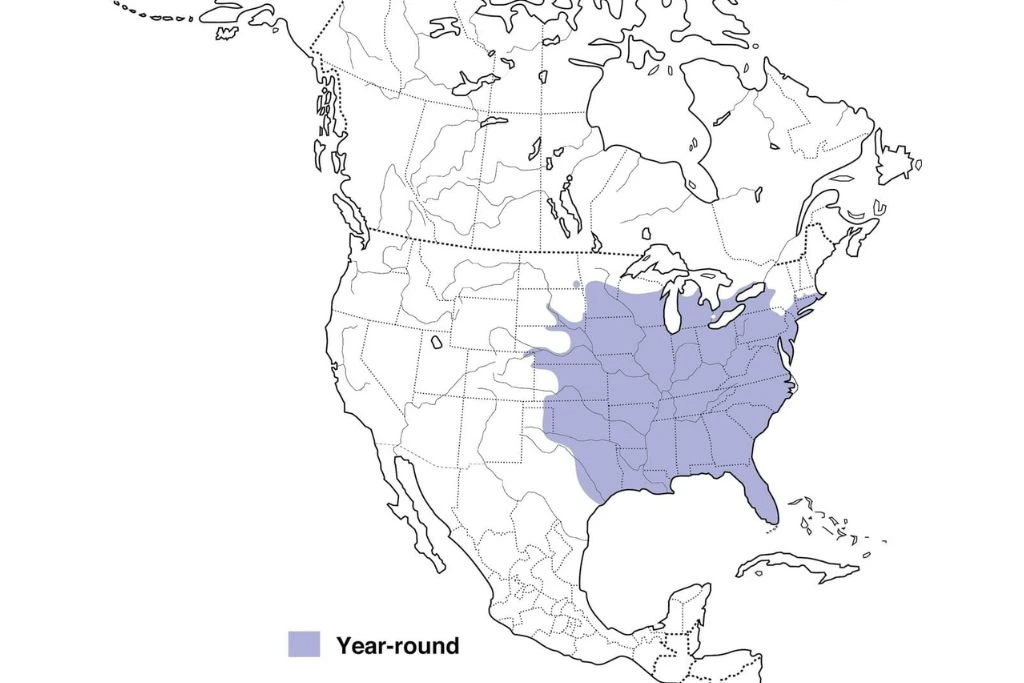
28. Rock Pigeon
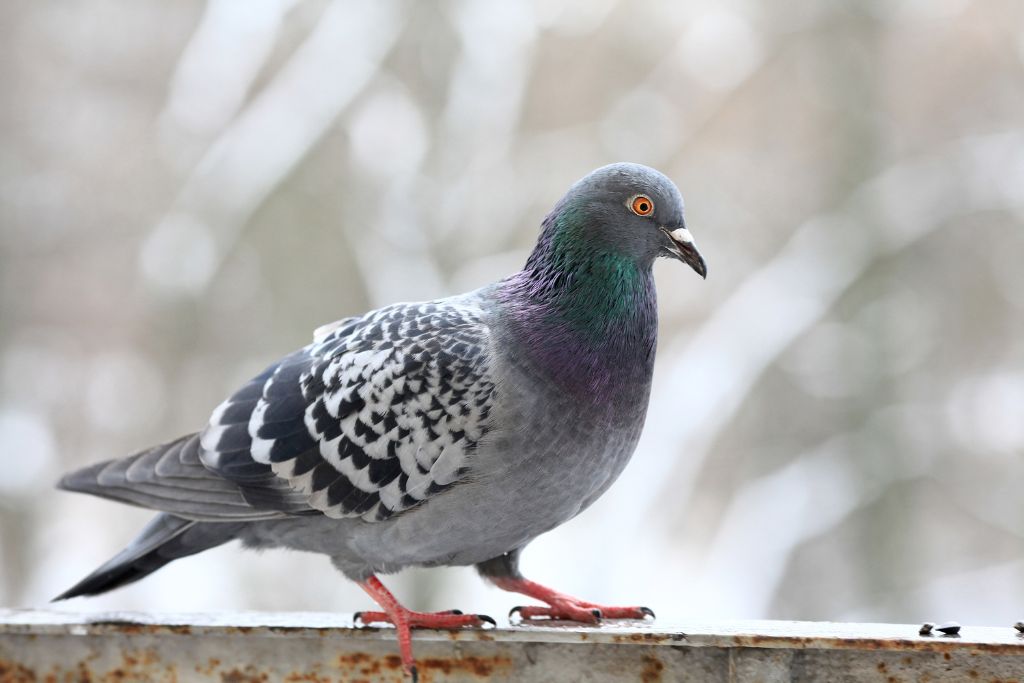
- Kingdom: Animalia
- Phylum: Chordata
- Class: Aves
- Order: Columbiformes
- Genus: Columba
- Species: C. livia
The colorful rock pigeon (Columba livia) has a plump body, short neck, and small head. The plumage can vary, but it often features a mix of gray, blue, and iridescent green hues. Adorned with dark irises, their eyes exude a sense of intelligence and curiosity.
These birds can fly through the busiest city streets with their 65-centimeter wingspan. Rock pigeons, affectionately called “city pigeons,” have adapted to urban environments. They can adapt to their surroundings utilizing ledges, buildings, and bridges as nesting sites.
These versatile birds use “eyestrain” to navigate crowded cityscapes by recognizing ultraviolet light, an ability few other birds have.
Rock pigeons can live up to 15 years in the wild. Their relatively long lifespan is a testament to their adaptability and resilience. In Florida, you can often spot these charismatic birds in various locations, including urban areas, parks, and gardens. They are common in urban and suburban Florida due to their instinct to seek out humans and food.
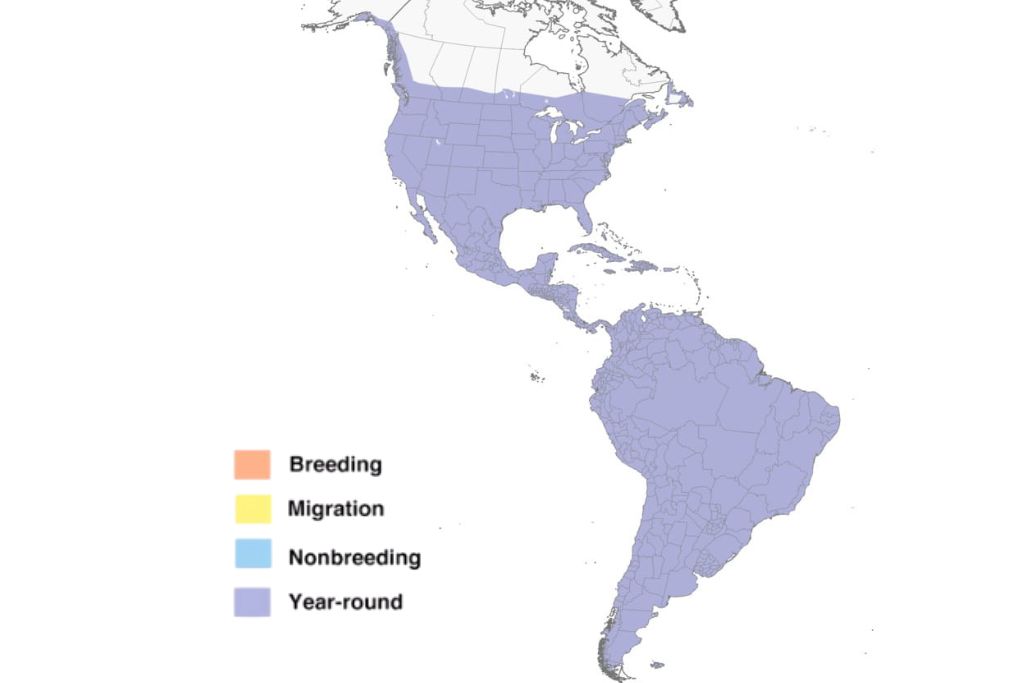
29. Ruby-Throated Hummingbird
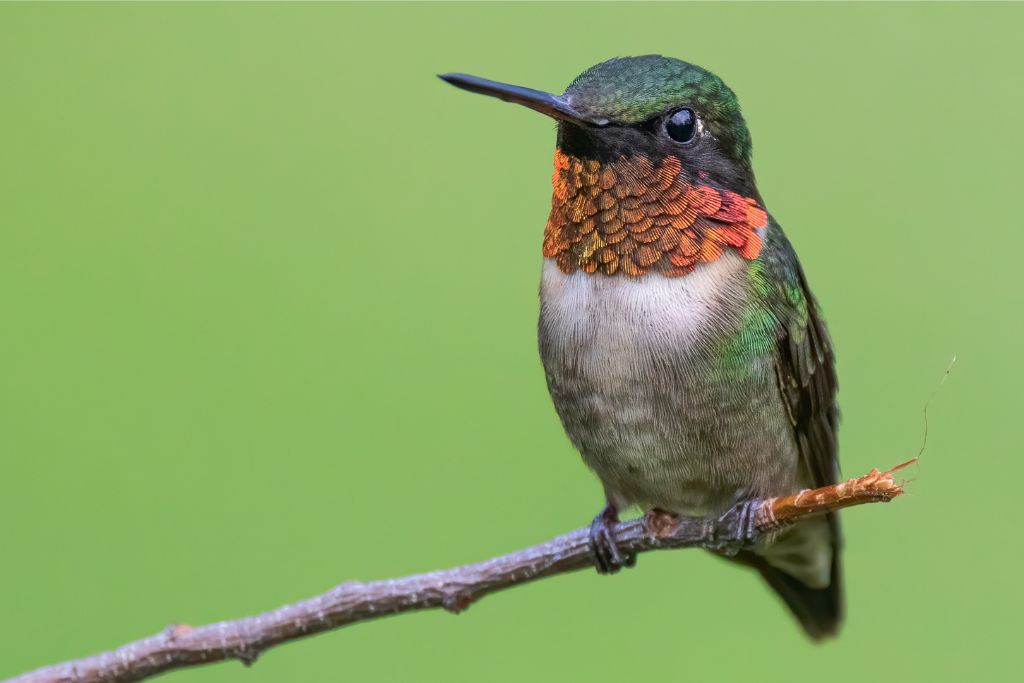
- Kingdom: Animalia
- Phylum: Chordata
- Class: Aves
- Order: Apodiformes
- Genus: Archilochus
- Species: A. colubris
Adult ruby-throated hummingbirds (Archilochus colubris) are only 3 to 3.75 inches long and weigh 0.1 to 0.2 ounces. Males have an iridescent emerald green back and a ruby-red throat, while females are more subdued green.
These birds possess long, slender bills ideally suited for probing nectar-rich flowers, their primary source of sustenance. Their wings beat up to 80 times each second, allowing them to hover and fly easily.
If you find yourself in the beautiful state of Florida, you have a good chance of spotting ruby-throated hummingbirds. These enchanting creatures are commonly found in a variety of habitats, including gardens, woodlands, and coastal areas. Their iridescent beauty and acrobatic flying patterns fascinate viewers in flower gardens, where they prefer nectar-rich blossoms.
Despite their small size, ruby-throated hummingbirds embark on an impressive migration journey. They fly nonstop for up to 500 miles across the Gulf of Mexico to reach their wintering grounds in Central America. One of the fastest animals on Earth, these birds can fly at 55 mph.
Male ruby-throated hummingbirds perform intricate courtship displays called “dive displays” to attract females. They climb high before diving in a U-shape, making a high-pitched chirping sound. They can live up to 10 years, although most live 3 to 5.
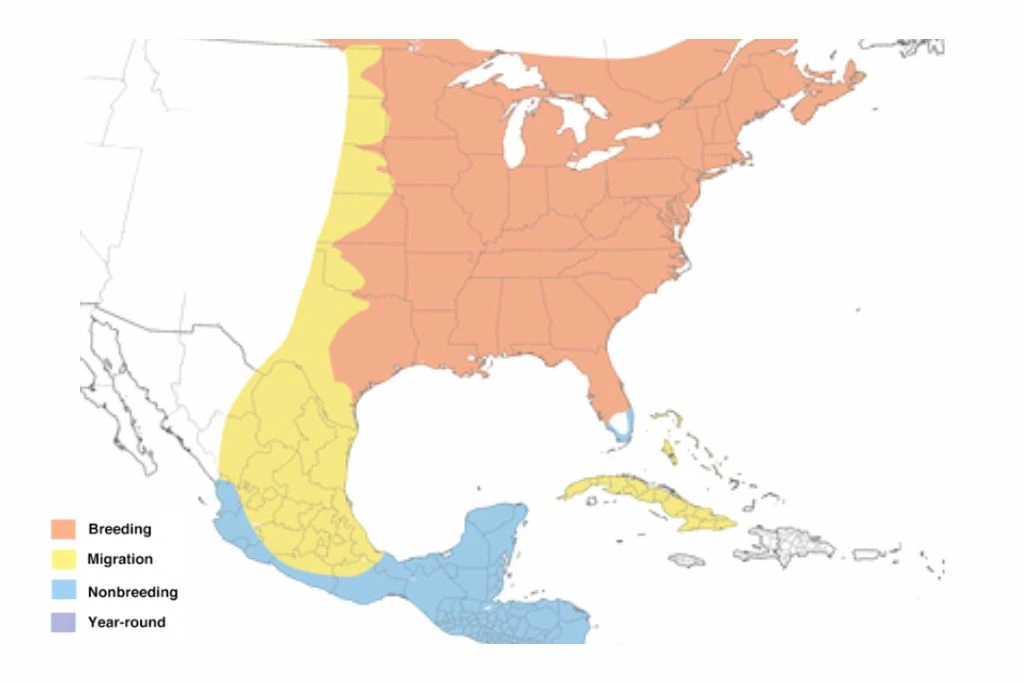
30. Rose-Breasted Grosbeak
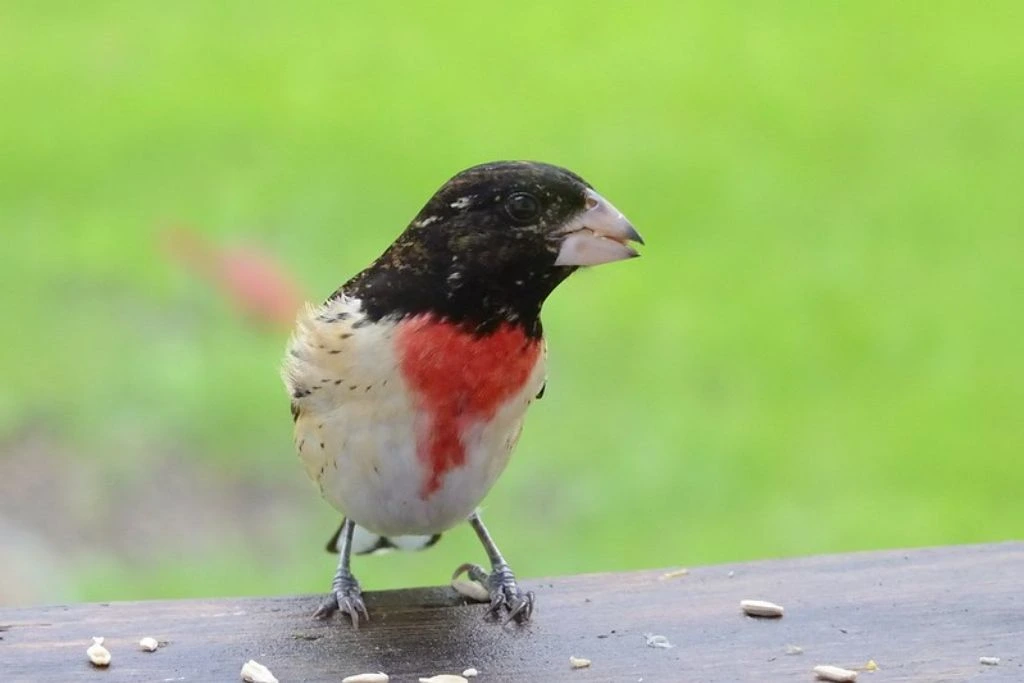
- Kingdom: Animalia
- Phylum: Chordata
- Class: Aves
- Order: Passeriformes
- Genus: Pheucticus
- Species: P. ludovicianus
The rose-breasted grosbeak (Pheucticus ludovicianus) attracts birdwatchers with its vibrant colors and distinctive features. The male of this species is striking with a black head and back and a rose-red breast patch. The female has brown and white feathers that match its surroundings.
These beautiful songbirds measure about 7 to 8 inches in length and have a wingspan of approximately 12 inches. They live in North American woodlands, forests, and shrublands. During the breeding season, they can be spotted in the eastern and central parts of the United States, including Florida.
Compared to other songbirds, grosbeaks can live up to 10 years in the wild. They eat insects, seeds, berries, and fruits. They can open seeds and collect nutrients with their powerful beak.
During migration, the rose-breasted grosbeak can be seen in Northern and Central Florida. They are commonly seen in wooded areas, including parks, nature reserves, and gardens with ample vegetation. If you meet one of these lovely birds, stop to admire their vibrant colors and melodic songs.
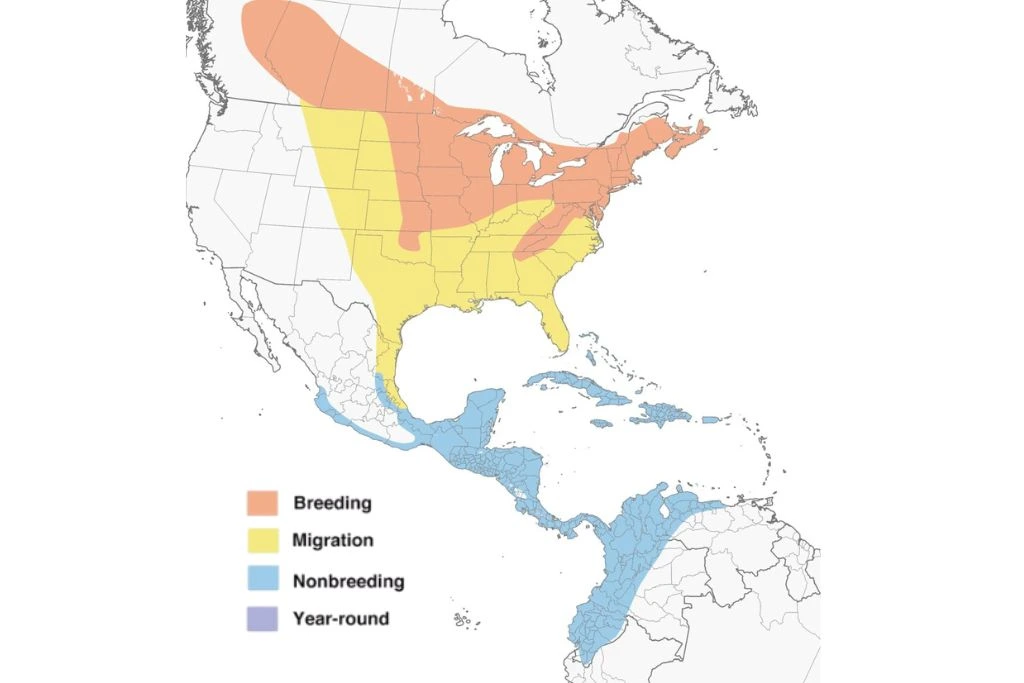
31. Swainson’s Hawk
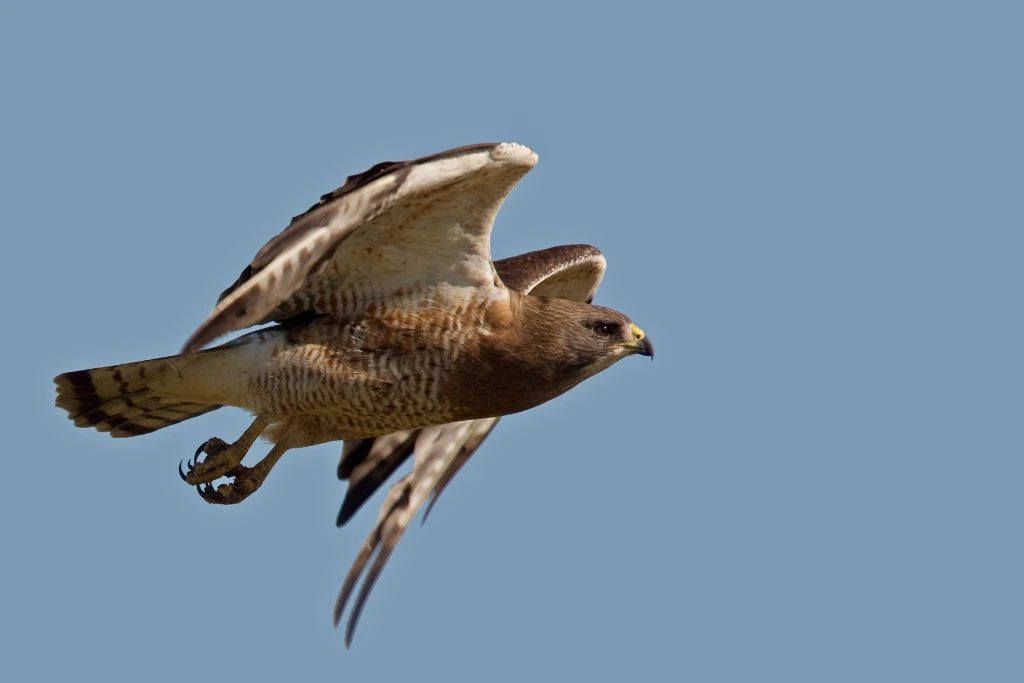
- Kingdom: Animalia
- Phylum: Chordata
- Class: Aves
- Order: Accipitriformes
- Genus: Buteo
- Species: B. swainsoni
Swainson’s hawk (Buteo swainsoni) is a magnificent bird belonging to the buteo hawk genus. It has a medium-sized body and a 4.5-foot wingspan, allowing it to fly gracefully. Most adults have brown and light gray feathers with a reddish-brown bib on the top chest.
This hawk’s hooked beak can tear apart prey, and its keen eyesight enables it to spot small mammals, birds, and insects from high up.
From North America’s Great Plains to South America’s pampas, the Swainson’s hawk is adaptable to many habitats. In summer, these hawks travel thousands of miles from South America to North America to reproduce. Their ability to catch thermal updrafts saves energy over extended flights, enabling their extraordinary migration.
This species has a relatively long life expectancy, with individuals living up to 15 years in the wild. Keep your eyes on the skies during these seasons to see these beautiful birds gracefully soaring overhead.
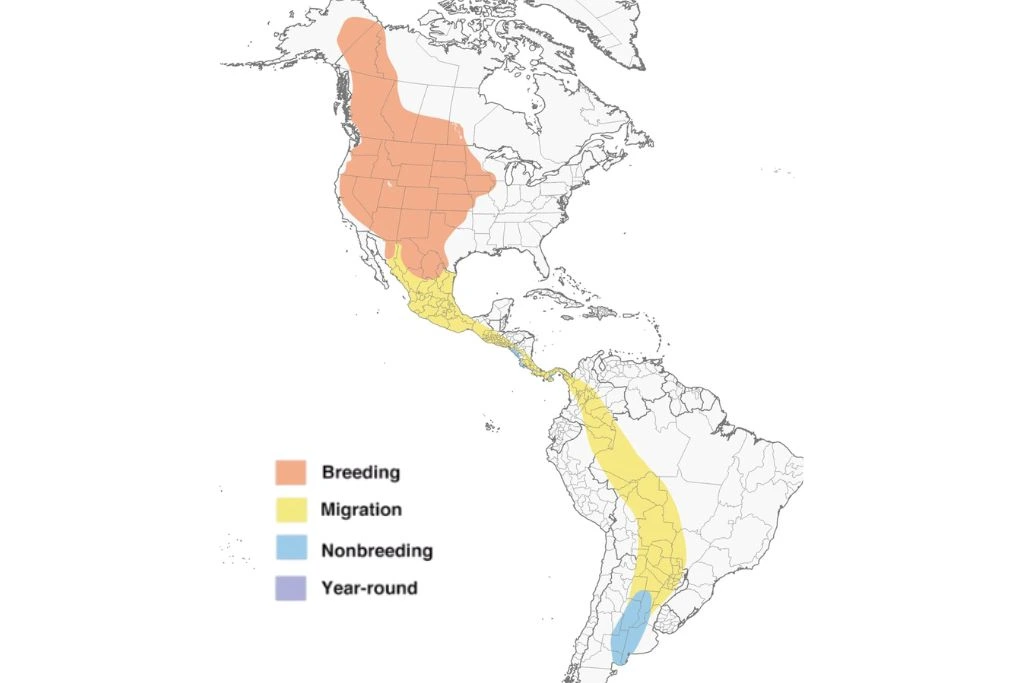
32. Song Sparrow
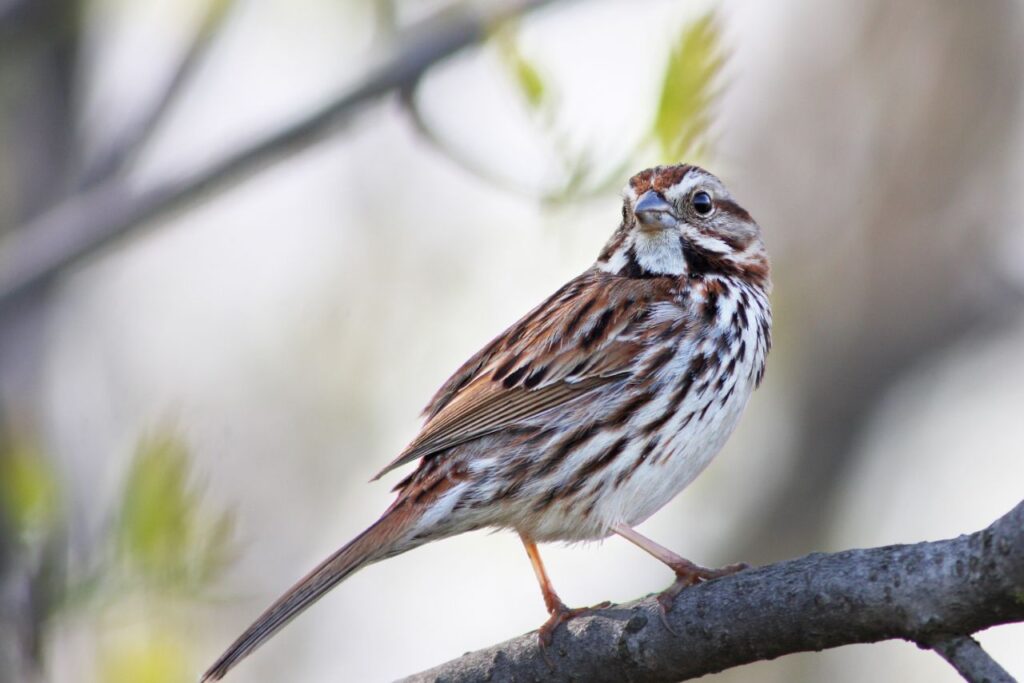
- Kingdom: Animalia
- Phylum: Chordata
- Class: Aves
- Order: Passeriformes
- Genus: Melospiza
- Species: M. melodia
Song sparrows (Melospiza melodia) are delightful little birds known for their musical tunes and charming appearances. Characterized by a plump body and a medium-sized beak, song sparrows exhibit various color variations. Their upper parts can be shades of brown, while their underparts are typically lighter with streaks or spots.
These birds’ distinct facial patterns, including a central dark spot on the chest, add to their allure. During the breeding season, they sing a vibrant and melodic song. Their beaks help them to efficiently search the ground for seeds, insects, and small invertebrates. Their long legs aid their hopping movements as they search for food or move through dense vegetation.
They may learn and imitate various bird songs, adding them to their repertoire. They also have regional dialects and sing differently depending on where they are.
These lovely birds can live up to 10 years in the wild, although most live 3 to 5. Florida’s beaches, salt marshes, and mangrove forests are prime locations to spot a song sparrow. They can also be found in urban areas with suitable vegetation and water sources.
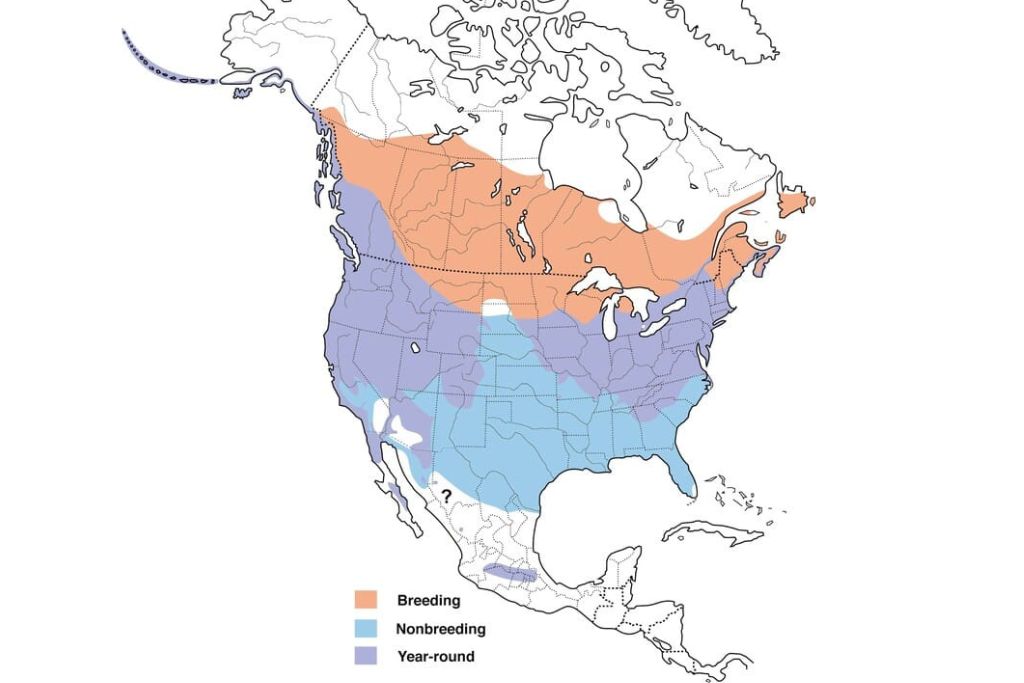
33. Scrub Jay
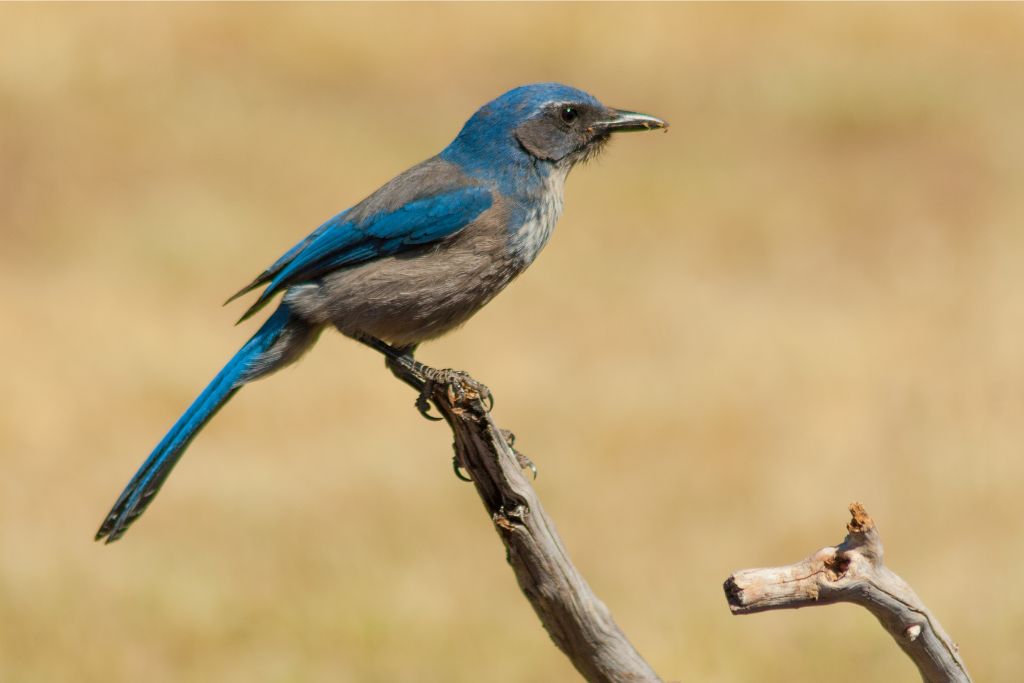
- Kingdom: Animalia
- Phylum: Chordata
- Class: Aves
- Order: Passeriformes
- Genus: Aphelocoma
- Species: A. californica
The scrub jay (Aphelocoma californica) is a fascinating bird species known for its vibrant plumage and unique behaviors. Found primarily in Florida, this charismatic avian is a delight to observe in its natural habitat.
They are medium-sized birds of about 10 inches in length, distinguished by their vivid blue feathers and a crest atop its head. Its brilliant blue color, white underparts, and black necklace-like marking across its throat are striking. This intelligent and social bird is bold and gorgeous.
The Florida scrub jay has adapted to scrubland and oak hammocks. Its sturdy beak is designed to crack open acorns and other tough seeds, which form a significant part of its diet. This bird has strong legs and feet, enabling it to forage on the ground and swiftly navigate through the dense foliage of its habitat.
With good care and conditions, these birds can live up to 17 years, which is relatively lengthy for birds. Scrub jays are found in scrubby habitats, sandhills, and open forests in Central and Southern Florida. Their adaptability to diverse habitats within Florida has contributed to their wide distribution throughout the region.
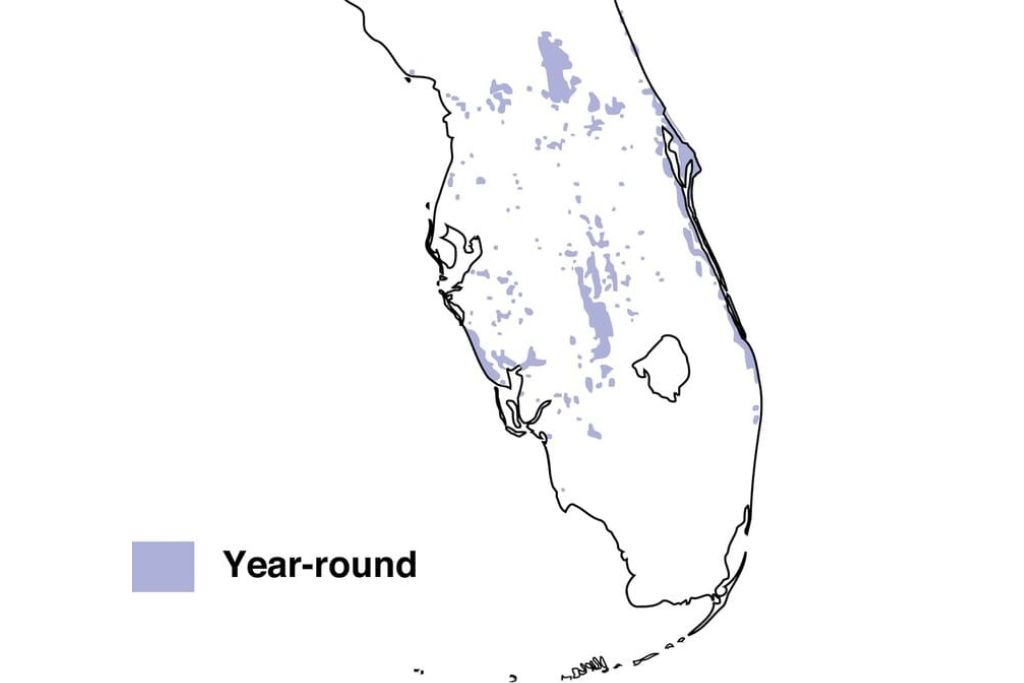
34. Tufted Titmouse
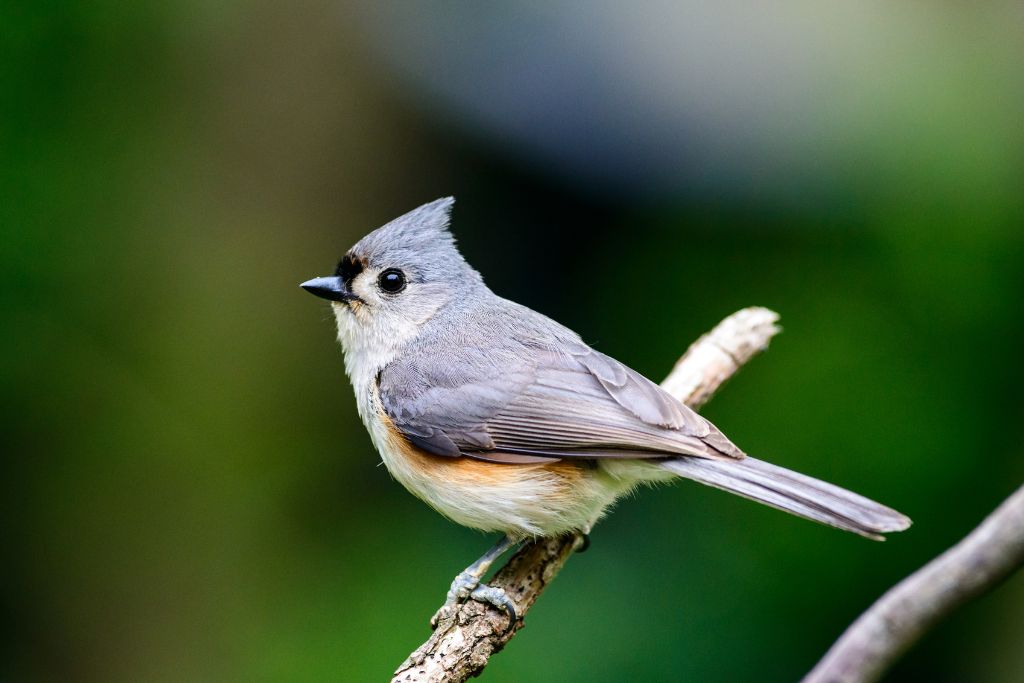
- Kingdom: Animalia
- Phylum: Chordata
- Class: Aves
- Order: Passeriformes
- Genus: Baeolophus
- Species: B. bicolor
The tufted titmouse (Baeolophus bicolor) is a cheerful bird in North American forests. This little songbird fascinates birdwatchers and nature lovers with its tufted crest and black, white, and gray coloring.
These agile birds have developed various adaptations that enable them to thrive in their woodland habitat. Their strong bills are ideally suited for cracking open seeds and nuts, which comprise a significant portion of their diet. They jump and cling to tree branches, using their muscular legs and feet to move across the trees.
They nest in tree cavities or woodpecker holes. The male titmouse gathers moss, bark, and leaves to build a nest from late spring to early summer. The female lays a clutch of 5 to 8 eggs, which she incubates for about two weeks.
These lively birds have a life expectancy of around 13 years, although some individuals have been known to live even longer. In Florida, they can be spotted throughout the state, primarily in areas with dense forests and woodland habitats. Keep your eyes and ears open for the tufted titmouse’s “peter-peter-peter” call among the rustling leaves and bird sounds.
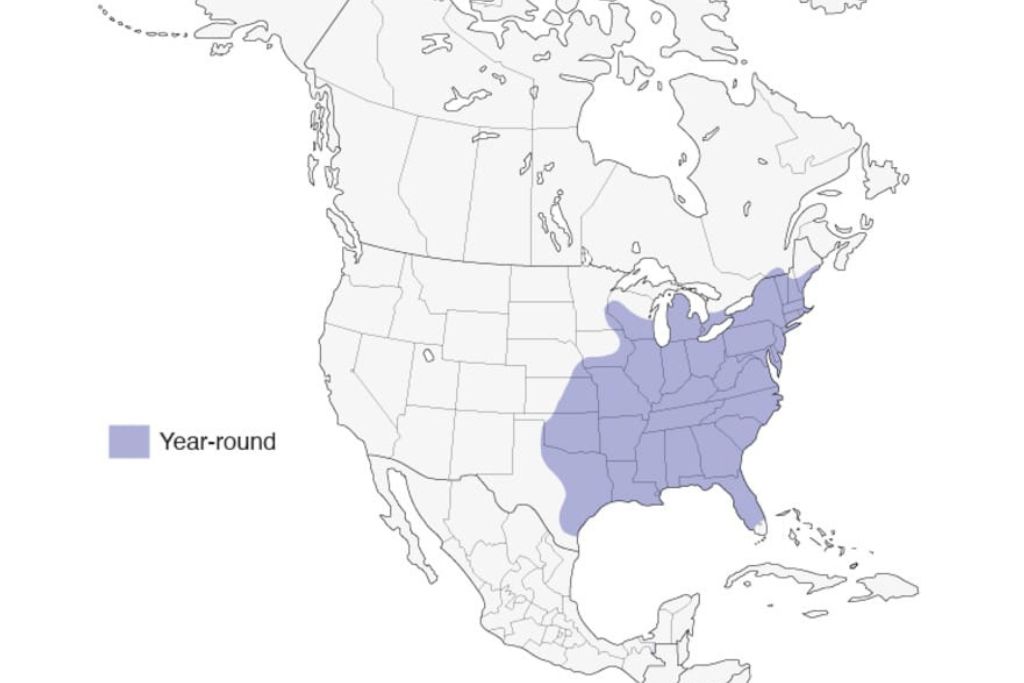
35. Yellow-Headed Blackbird
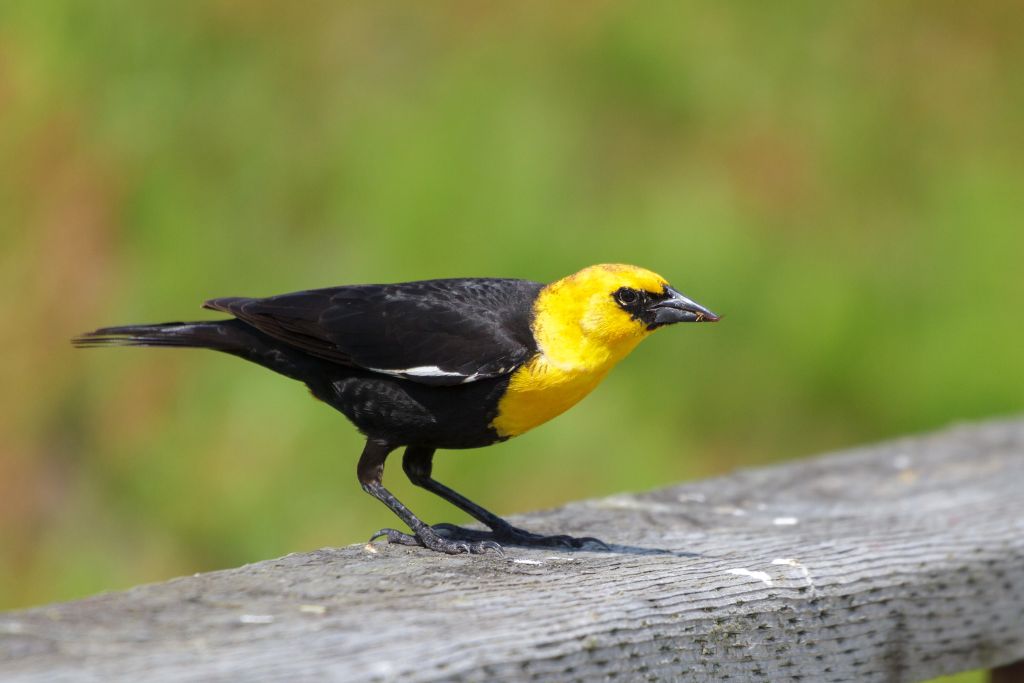
- Kingdom: Animalia
- Phylum: Chordata
- Class: Aves
- Order: Passeriformes
- Genus: Xanthocephalus
- Species: X. xanthocephalus
The yellow-headed blackbird (Xanthocephalus xanthocephalus) has a vibrant yellow head, contrasting beautifully with its black body. The male yellow-headed blackbird has a striking golden crown from its beak to its back. In contrast, the female is more subdued, with dark brownish-black plumage. Both genders have sturdy, pointed beaks, ideal for their foraging habits.
These remarkable birds have developed several adaptations that enable them to thrive in their preferred marshland habitats. Yellow-headed blackbirds can quickly fly through dense vegetation and open fields due to their long, pointed wings. Their unique beaks match their diet of seeds, insects, and tiny aquatic organisms.
Males build territories and perform elaborate courting displays in large colonies throughout the breeding season. Females weave reeds, grasses, and other plant materials into sturdy, well-hidden nests.
These birds can bond with their colonies and contribute to the population over their 10-year lifespan. They move across wetland ecosystems, like the Everglades in Florida, to find shelter and food.
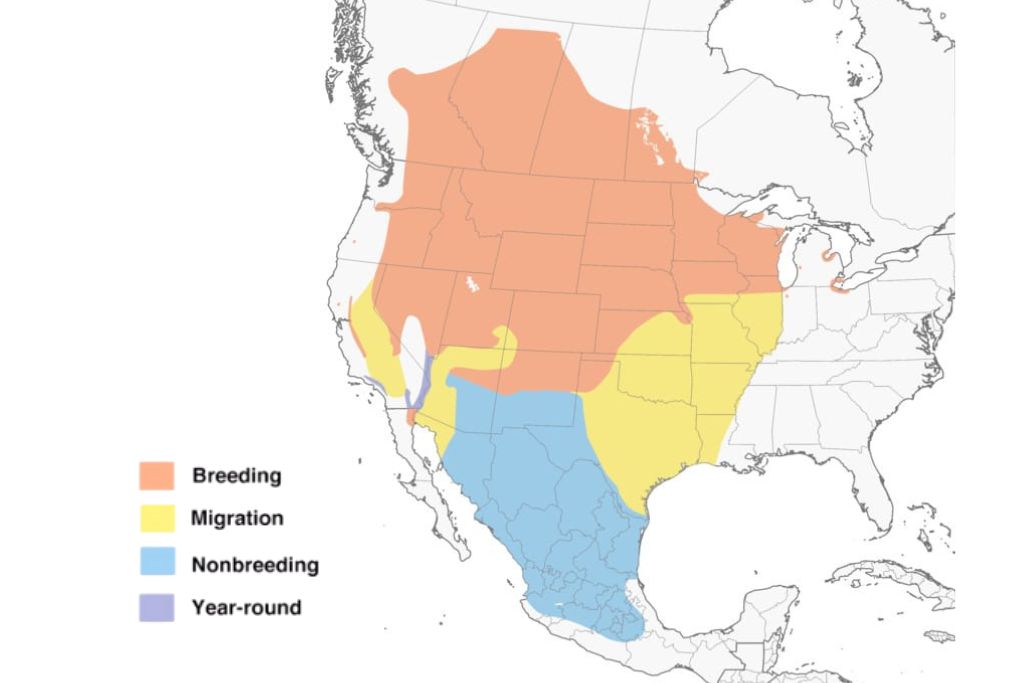
36. Wood Stork
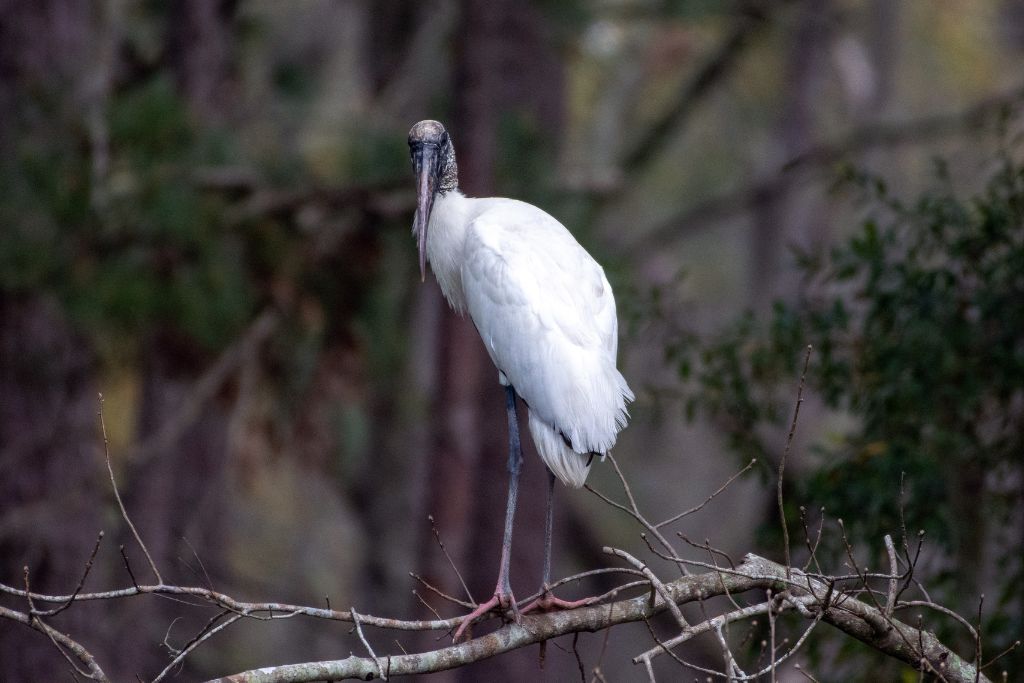
- Kingdom: Animalia
- Phylum: Chordata
- Class: Aves
- Order: Ciconiiformes
- Genus: Mycteria
- Species: M. americana
Wood storks (Mycteria americana) are distinctive due to their size and appearance. These beautiful birds stand tall at 3.5 feet and have a 5 to 6 feet wingspan. Their bodies are predominantly white, with black flight feathers and a striking bald head that is grayish-black in color. It regulates body temperature by spreading heat, especially in summer.
Their long, sturdy legs are ideal for wading through shallow waters, enabling them to search for prey. Their long, curved bills are designed to catch small fish, amphibians, crustaceans, and other aquatic creatures. They “grope feed” to quickly sweep their bills in the water and close them when they find something.
These magnificent birds can live up to 20 years in the wild, demonstrating their remarkable resilience and adaptability. They are considered an indicator species for the health of wetland ecosystems. Their presence and breeding success are directly linked to the availability of suitable habitats and the abundance of prey.
In Florida, wood storks are commonly spotted in various locations, particularly in wetlands, marshes, and estuaries. These gorgeous birds can be seen in the Everglades National Park, Lake Okeechobee, and Big Cypress National Preserve. Their distinctive appearance and graceful flight make them a true spectacle in the Sunshine State.
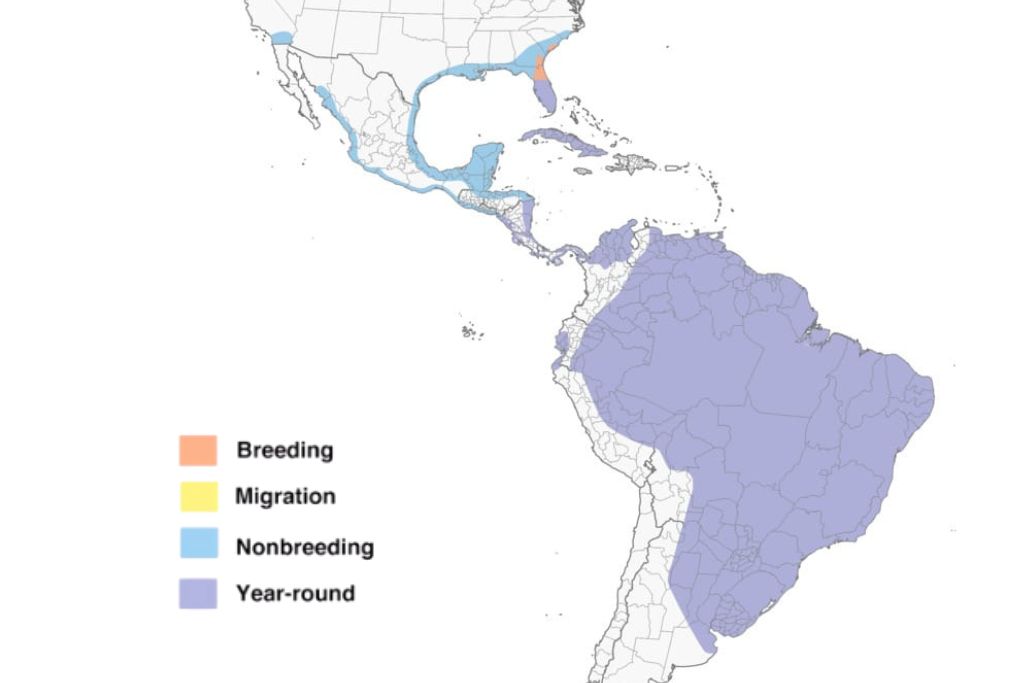
37. White-Breasted Nuthatch
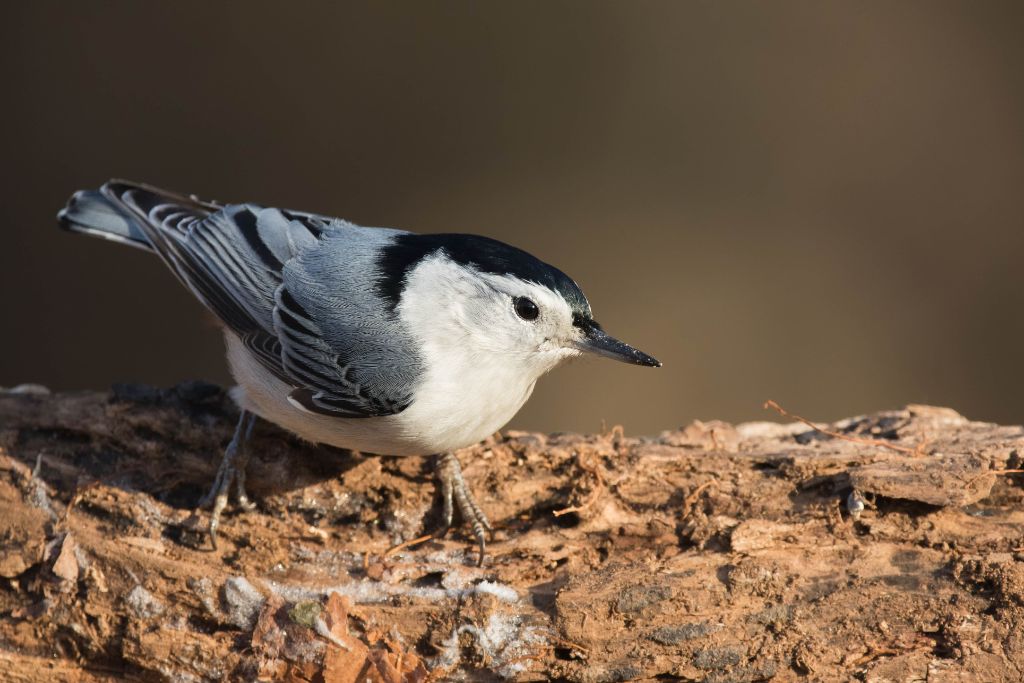
- Kingdom: Animalia
- Phylum: Chordata
- Class: Aves
- Order: Passeriformes
- Genus: Sitta
- Species: S. carolinensis
Birdwatchers love the white-breasted nuthatch’s (Sitta carolinensis) unique appearance and behavior. This little bird has a jet-black crown and a clean white belly. Its name originates from the unique behavior of wedging nuts into crevices and using its strong bill to crack them open.
One notable adaptation is its strong legs and sharp claws, enabling it to maneuver head-first down tree trunks effortlessly. Its climbing ability, curved bill, and long, straight hind toe assist it in finding hidden insects and spiders under tree bark. You’ll often find these charming little birds exploring tree branches, hopping and darting sideways with grace and precision.
These tiny birds are masters of disguise. They can mimic the calls of other species, allowing them to deceive potential predators or competitors. Their habit of storing food for later consumption is fascinating and essential during hard winters when food is limited.
White-breasted nuthatches typically live 2 to 3 years, although some have lived up to 9 years.
These birds live in deciduous and mixed forests, as well as urban and suburban with enough tree cover in Florida. They hunt insects and seeds in tree trunks and branches, primarily oak and pine trees. If you hear its nasal “yank-yank” call, you may spot the attractive white-breasted nuthatch wandering Florida’s stunning surroundings.
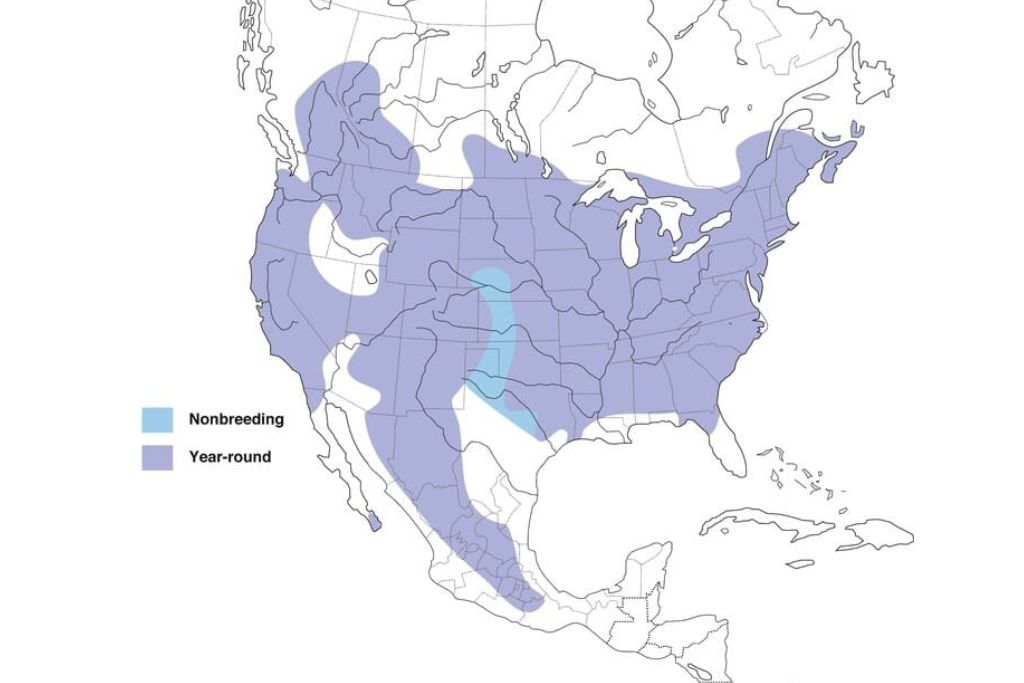
38. White-Throated Sparrow
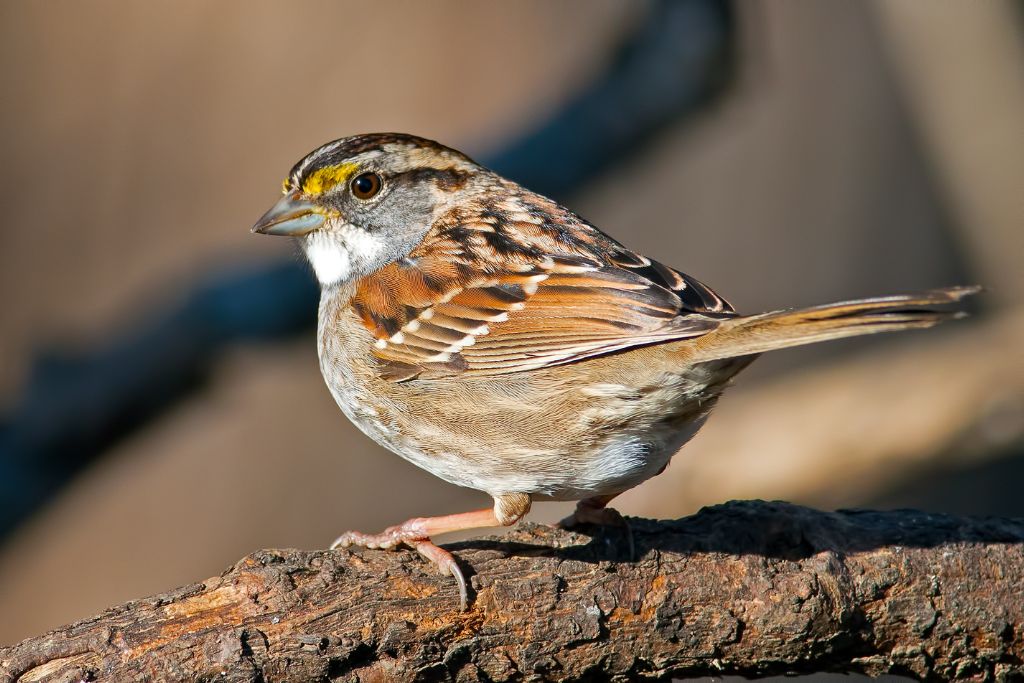
- Kingdom: Animalia
- Phylum: Chordata
- Class: Aves
- Order: Passeriformes
- Genus: Zonotrichia
- Species: Z. albicollis
White-throated sparrows (Zonotrichia albicollis) are medium-sized sparrows found in North American woodlands and shrublands. Characterized by its crisp black-and-white striped crown, the white-throated sparrow possesses a striking appearance. The gold between its eye and the bill warms its gorgeous plumage.
As its name suggests, this sparrow’s white throat patch stands out against its soft grayish-brown feathers. Both males and females possess this unique trait, although the male’s markings tend to be more vivid and defined.
One of its notable features is its conical bill, which is perfectly designed for cracking open seeds and foraging on the forest floor. Its fast flight and strong legs let it hop and scratch the ground for insects and grains. Males establish their territories in spring and early summer by whistling “Oh sweet Canada, Canada, Canada” and trilling.
This avian species exhibits remarkable geographic variation in its song, with distinct dialects varying across different regions. They form monogamous pairs and usually stay with their partners throughout the breeding season. According to studies, they may navigate using Earth’s magnetic fields during migration.
In the wild, the white-throated sparrow lives for about 2 to 3 years, but some have lived up to 9 years. Predation, habitat loss, and other environmental factors can affect their lifespan. Despite these challenges, this songbird charms nature lovers with its tunes and fascinating presence in North American woodlands and gardens.
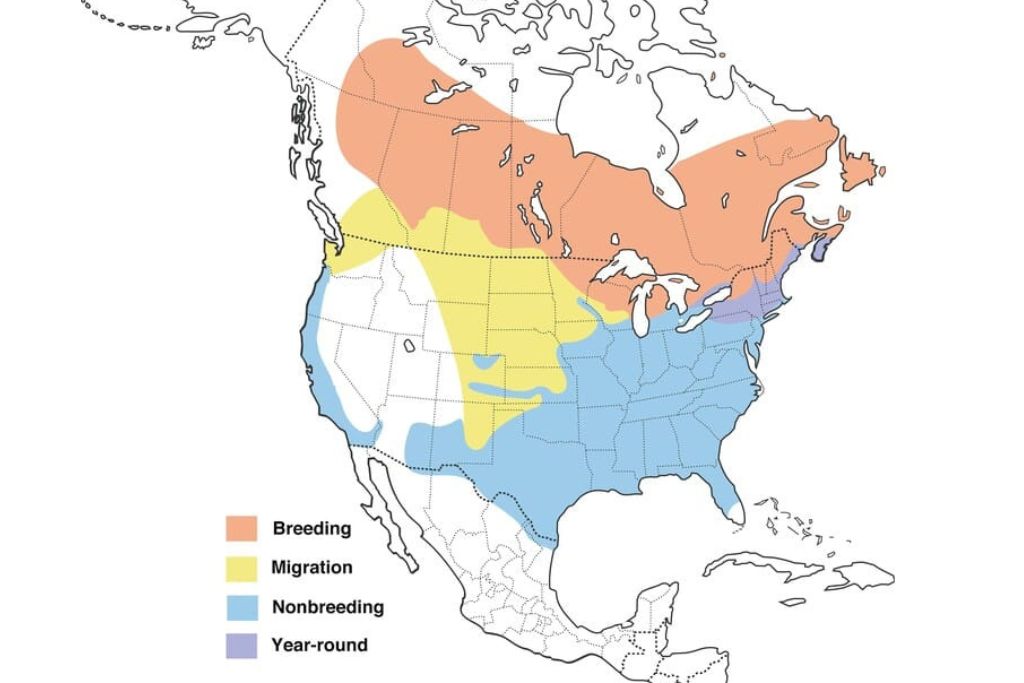
FAQs
What is the Most Common Bird in Florida?
The most common bird in Florida is the northern mockingbird (Mimus polyglottos).
What Bird is Only Found in Florida?
The only bird found in Florida is the Florida scrub jay (Aphelocoma coerulescens).
What is the Biggest Bird in Florida?
The biggest bird in Florida is the American white pelican (Pelecanus erythrorhynchos).

